English lexicology Lecture 2. The International Structure of

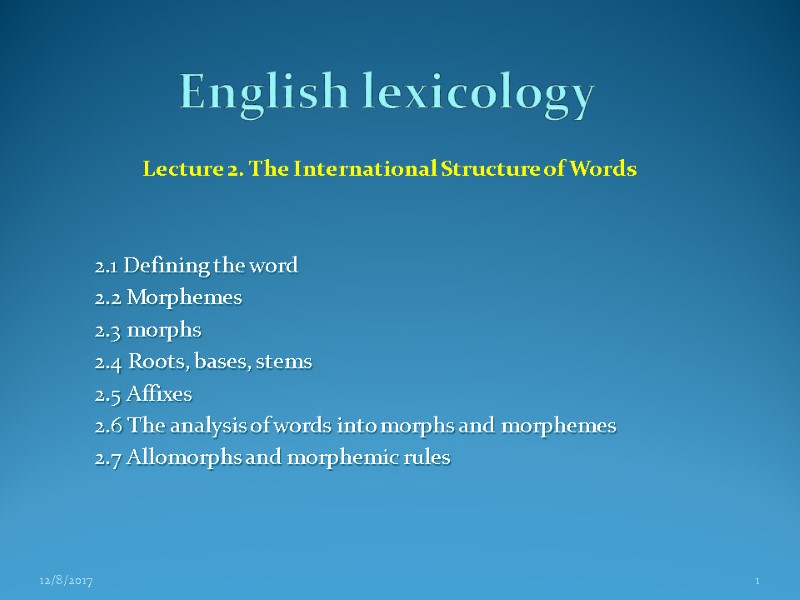
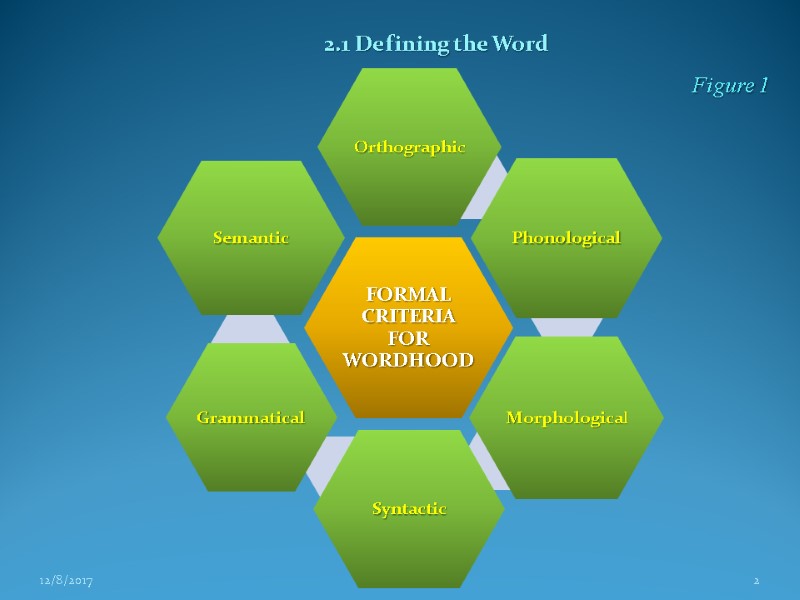
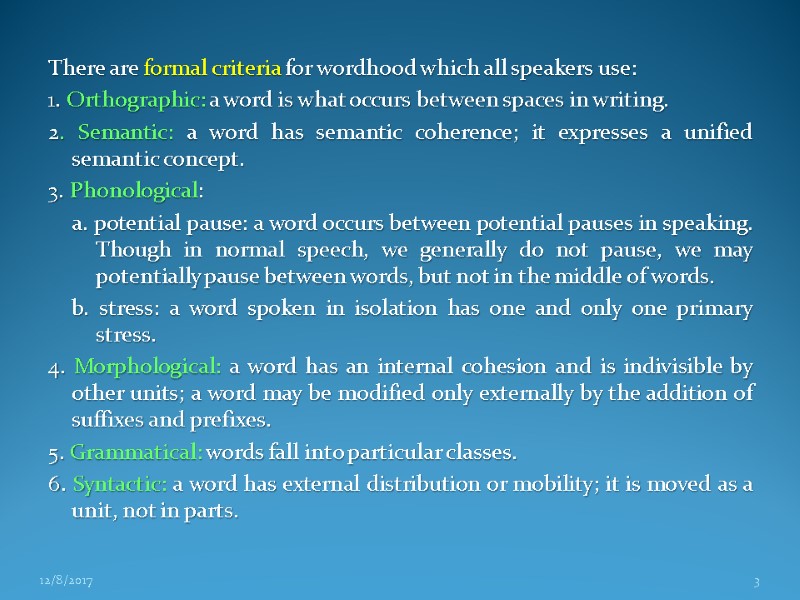
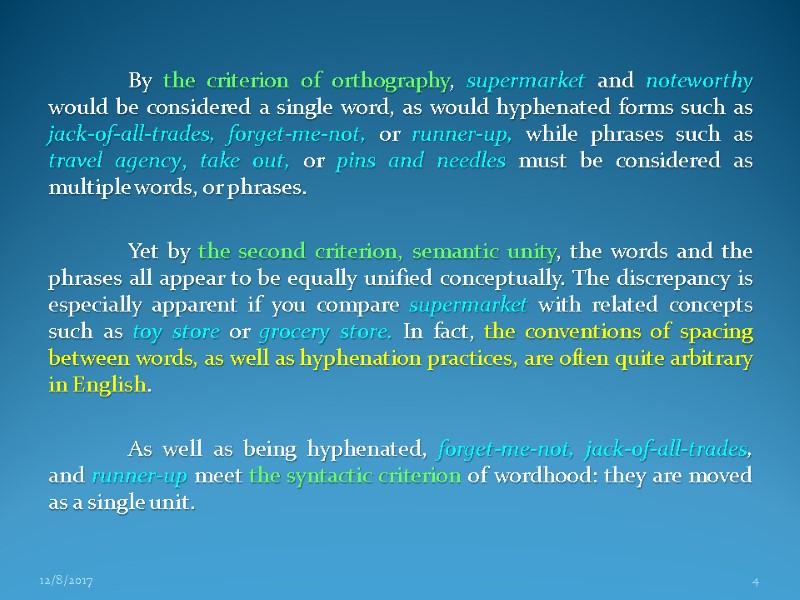
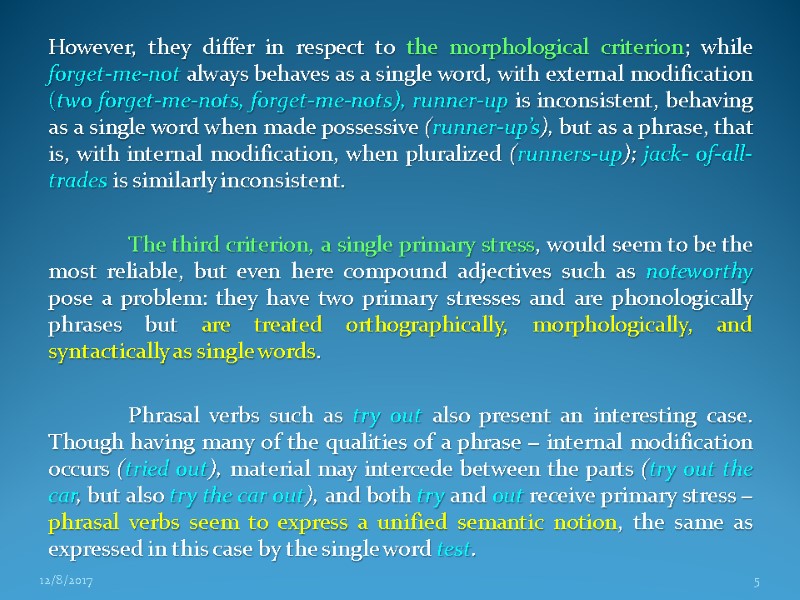
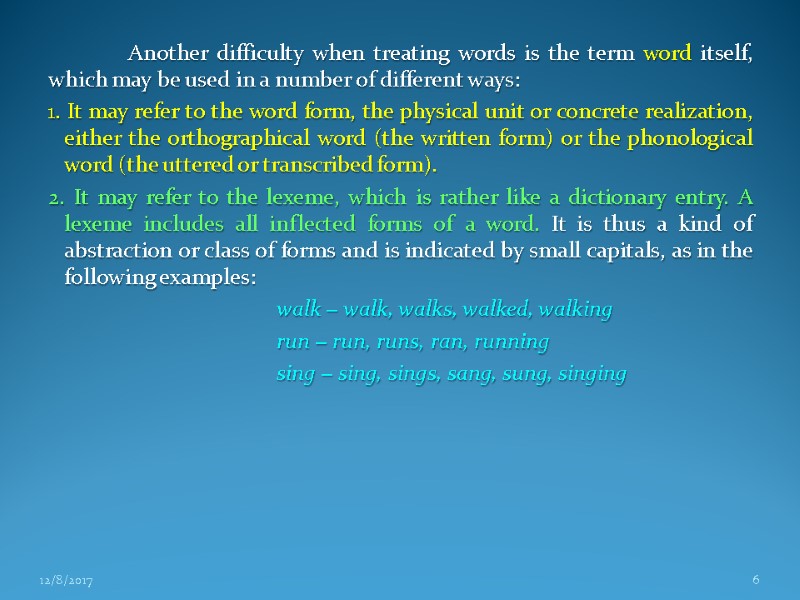
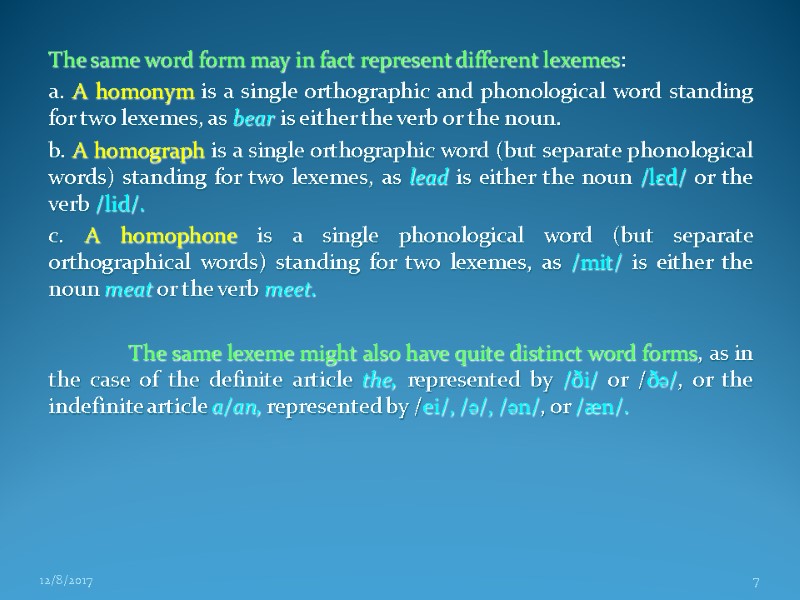
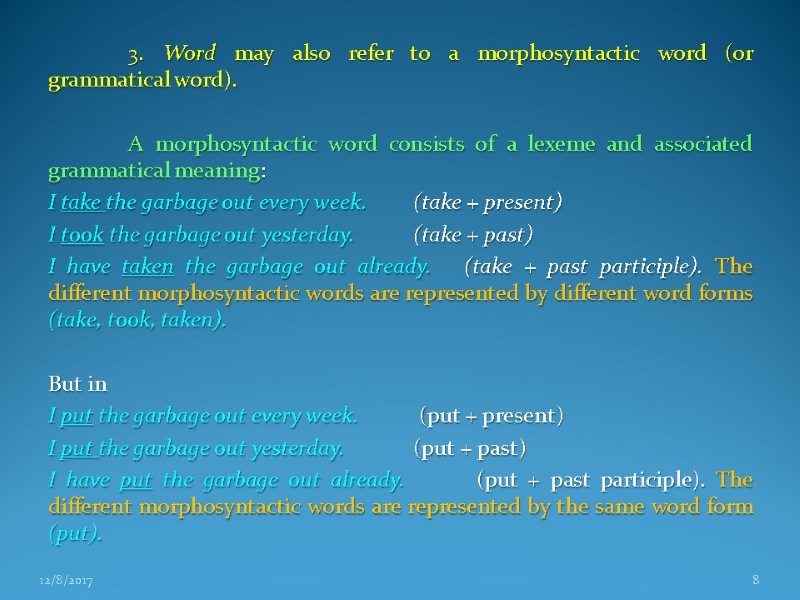
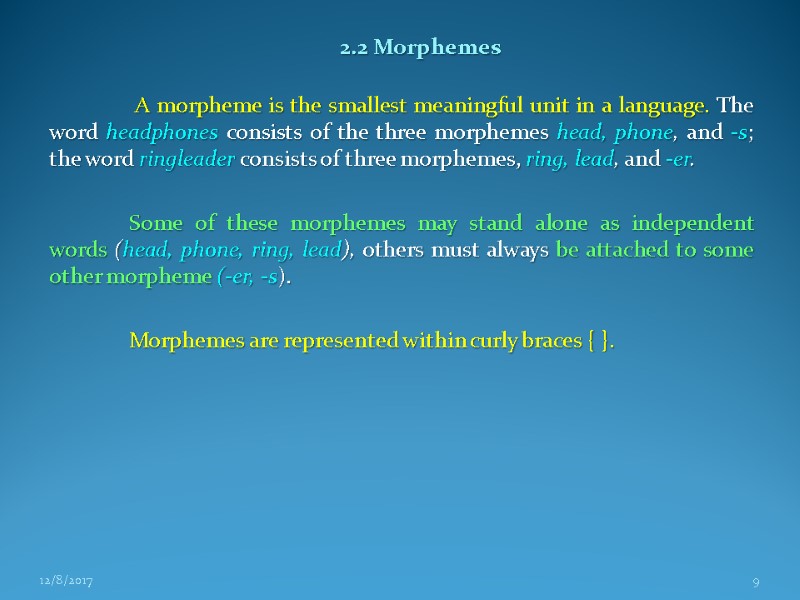
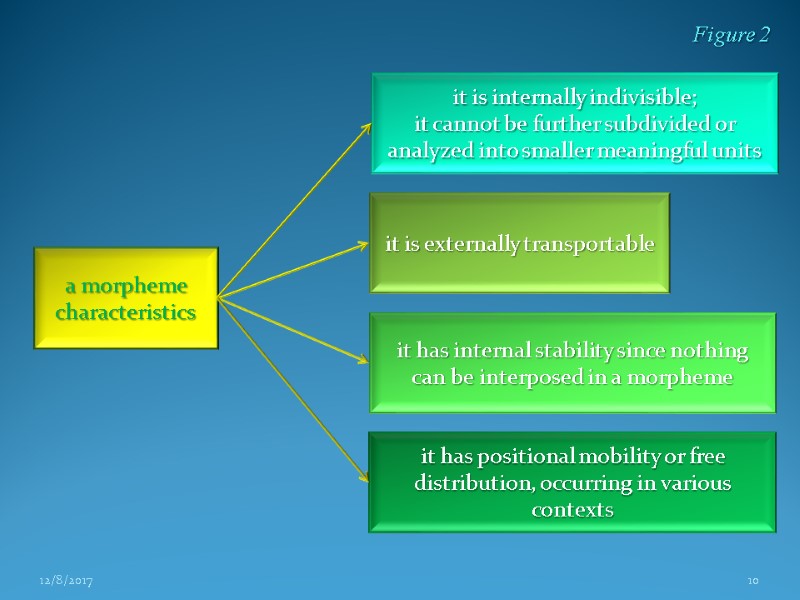
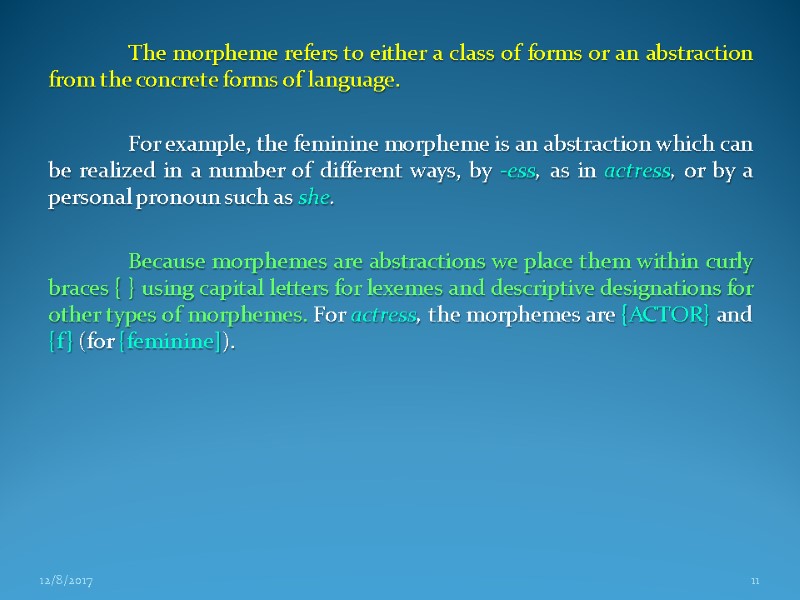
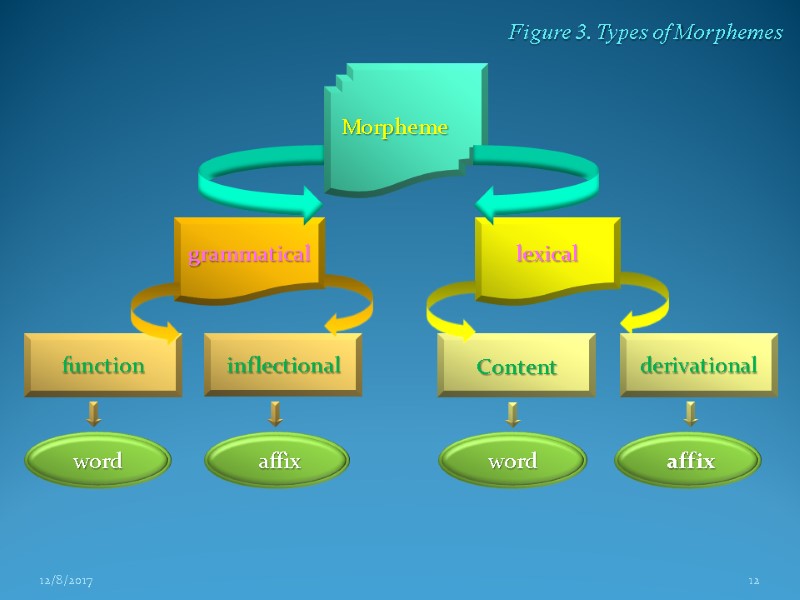
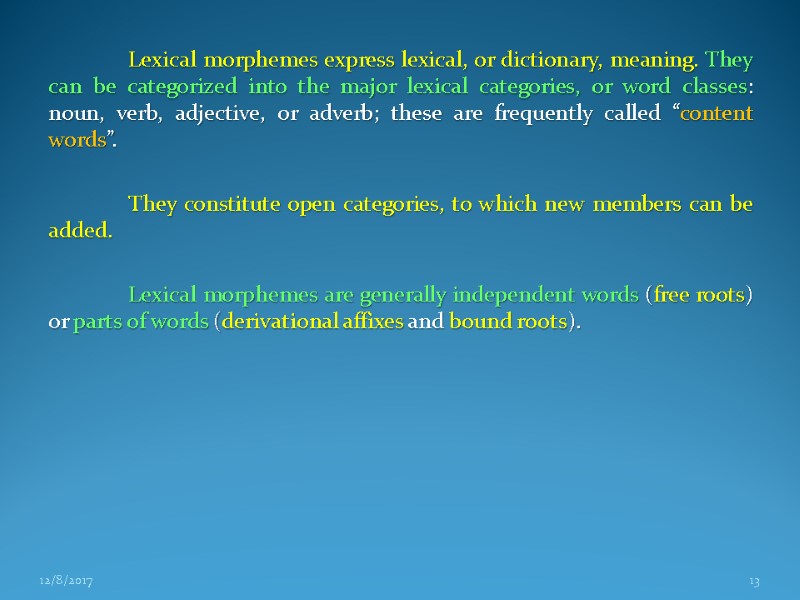
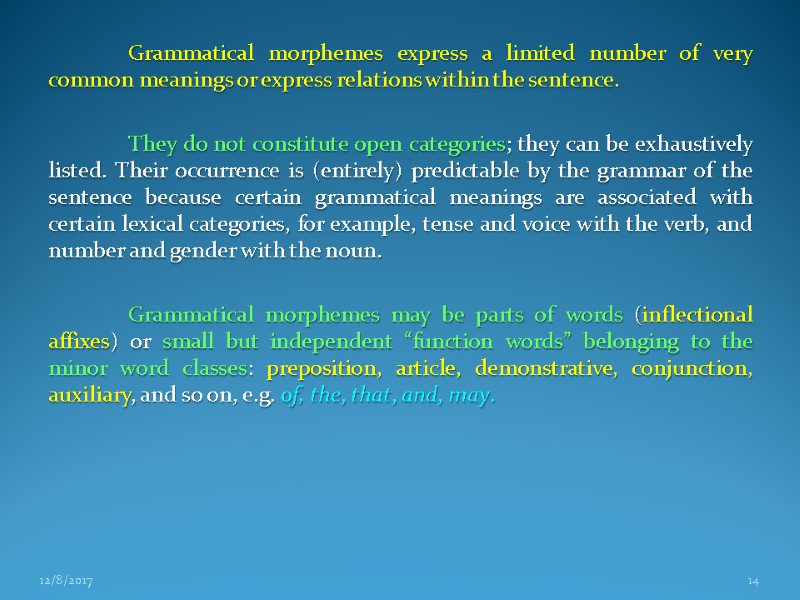
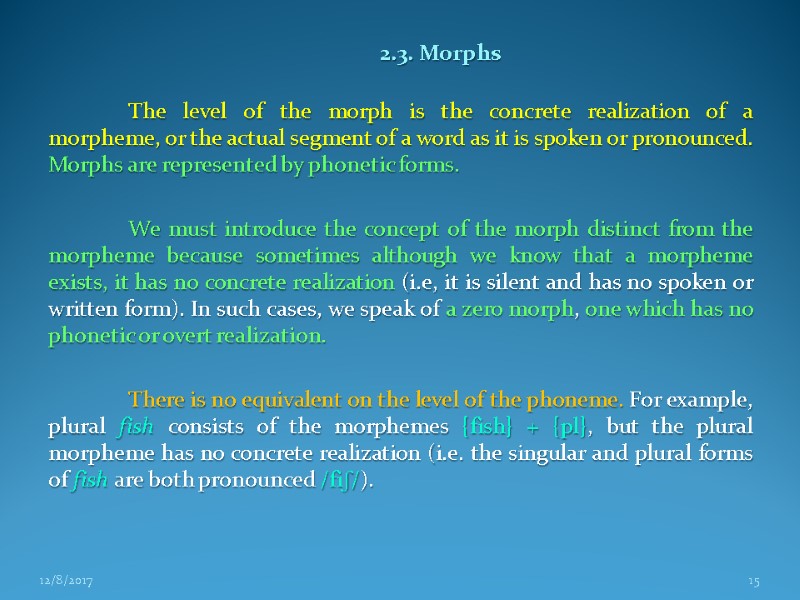
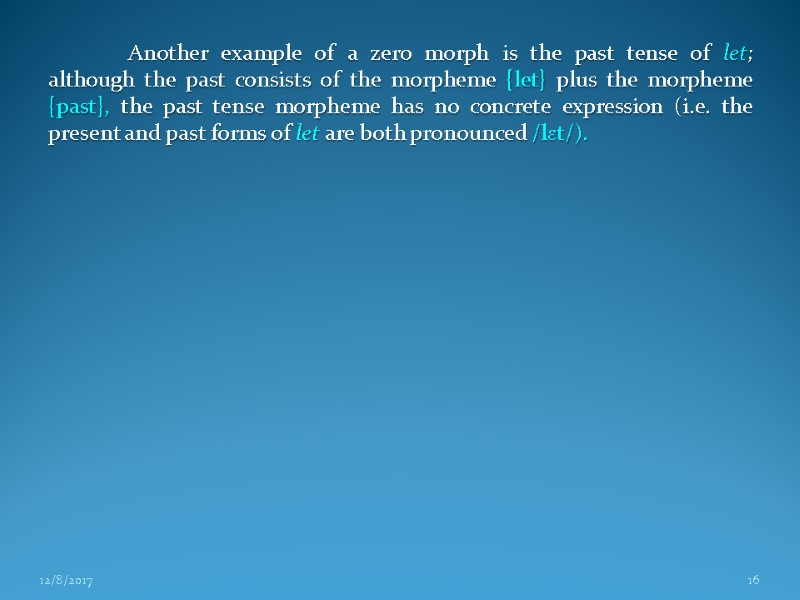
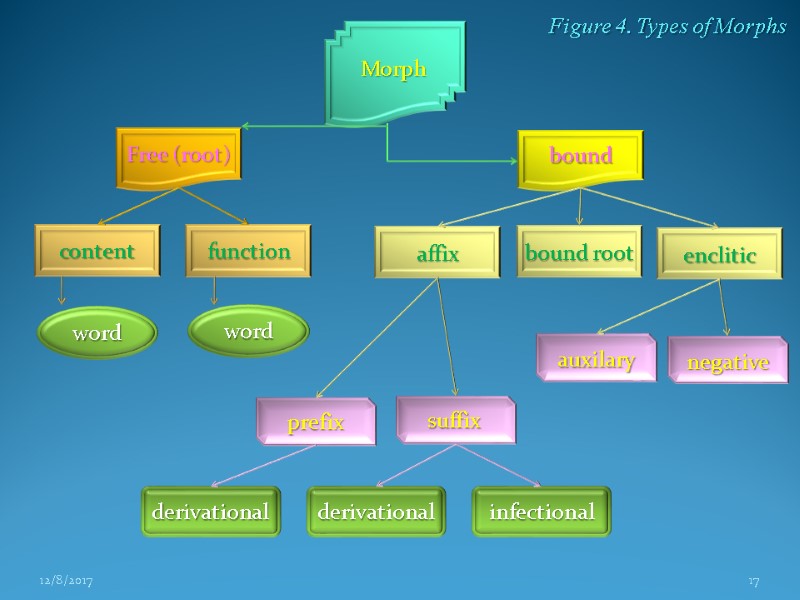
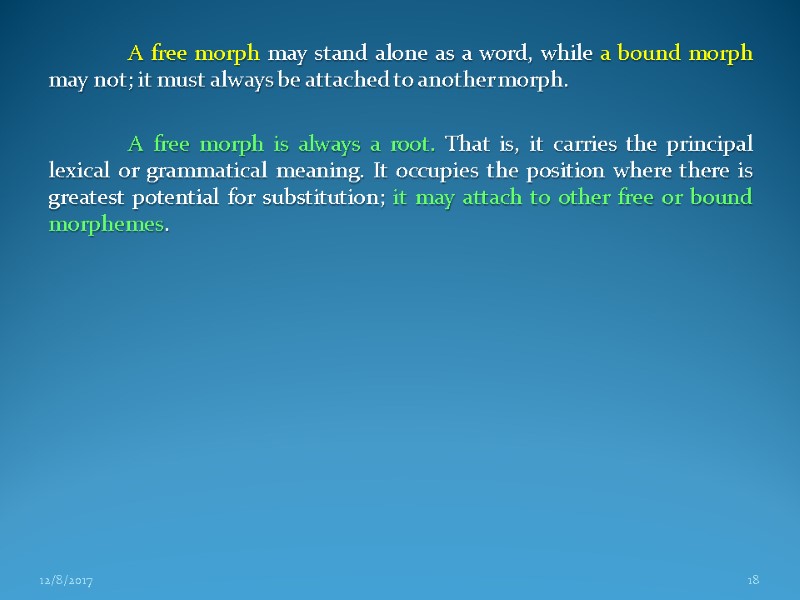
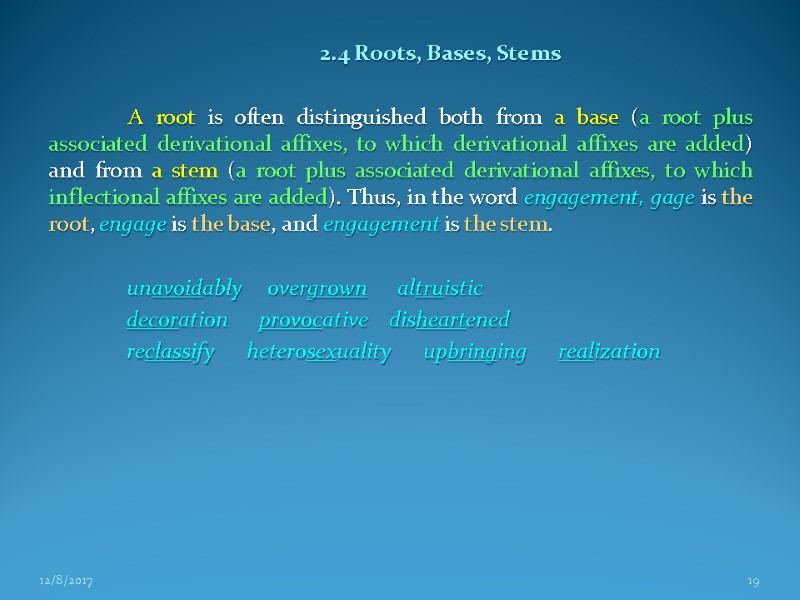
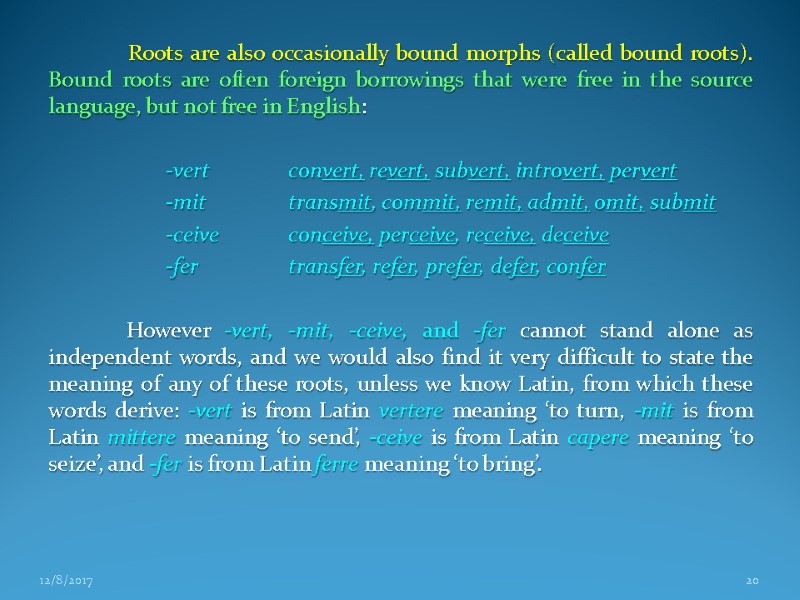
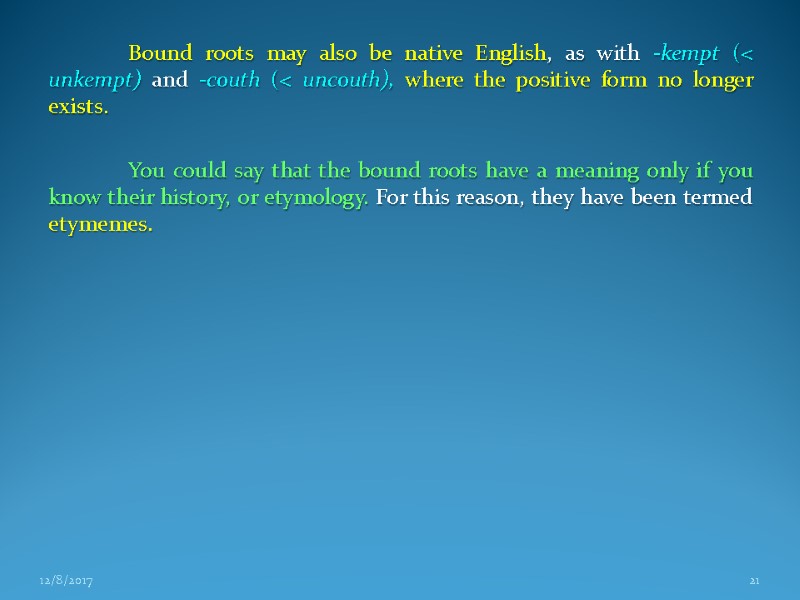
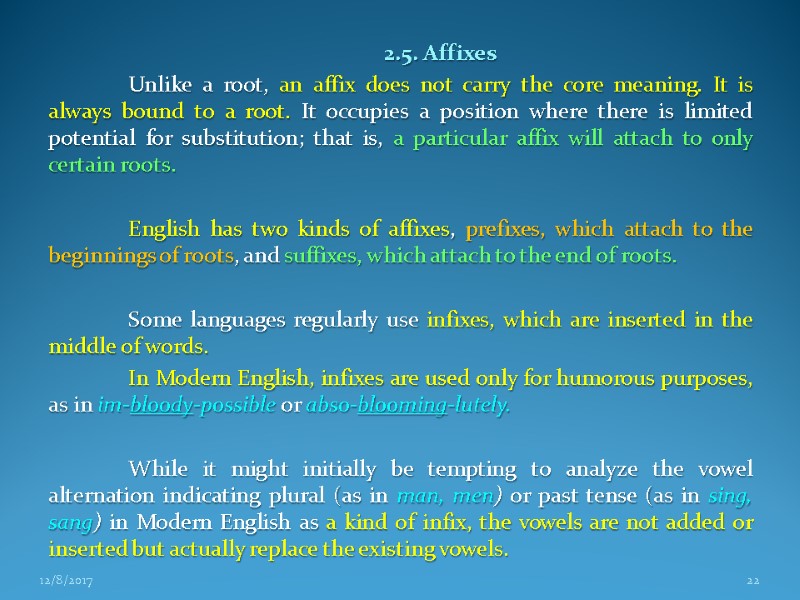
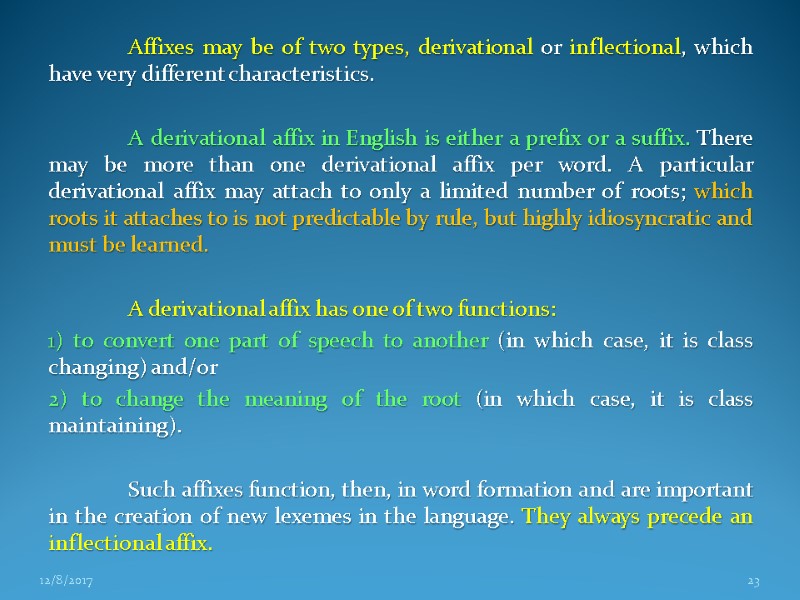
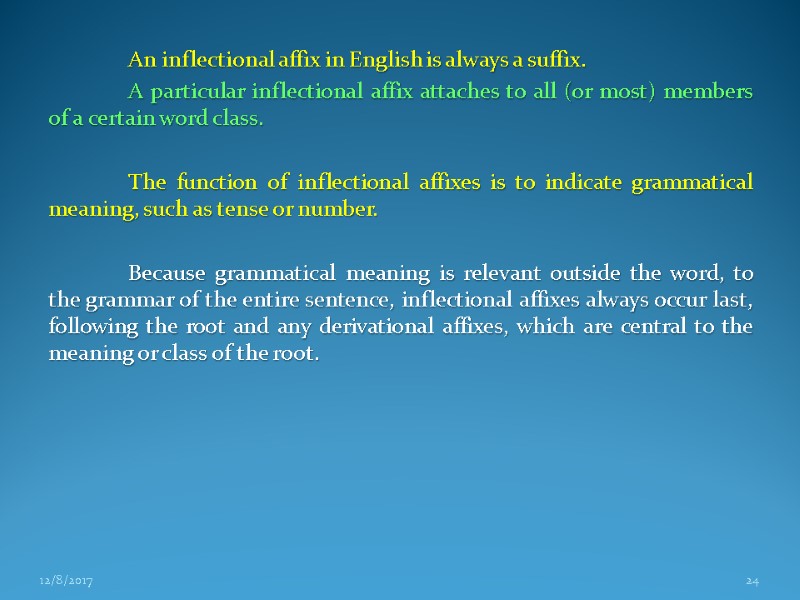
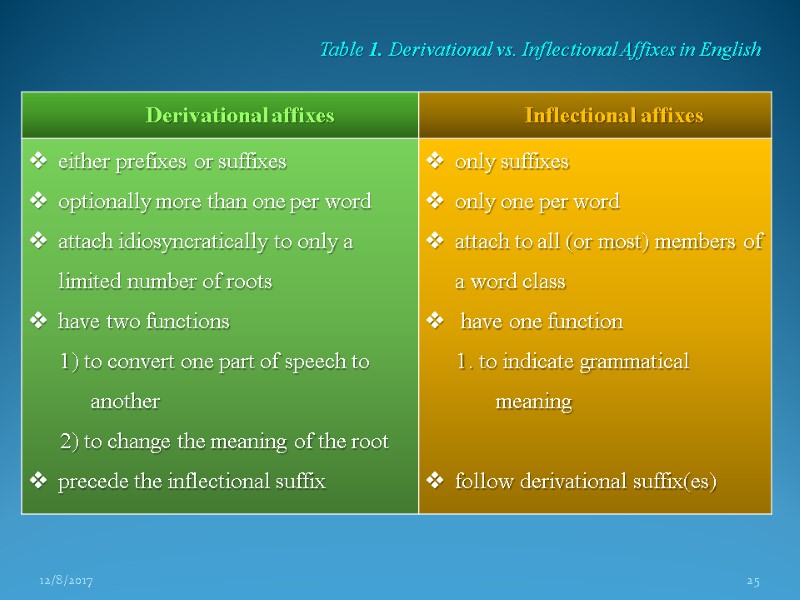
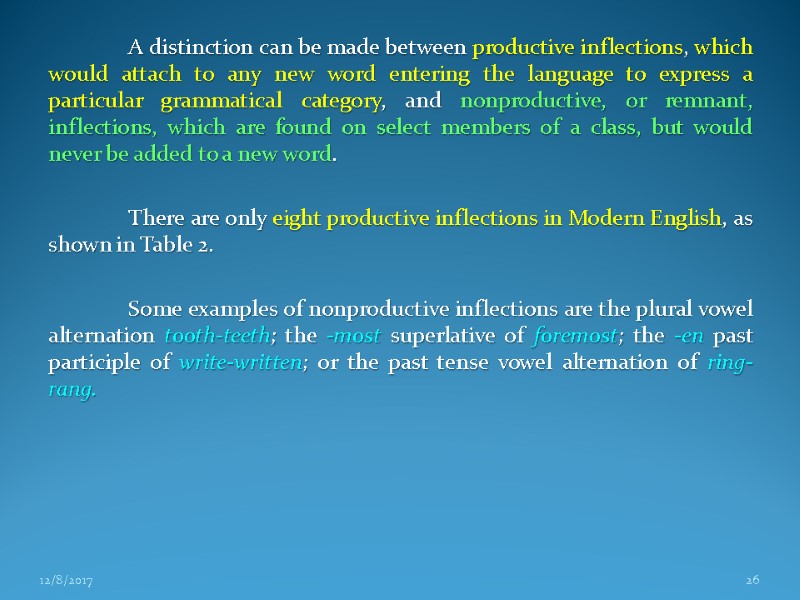
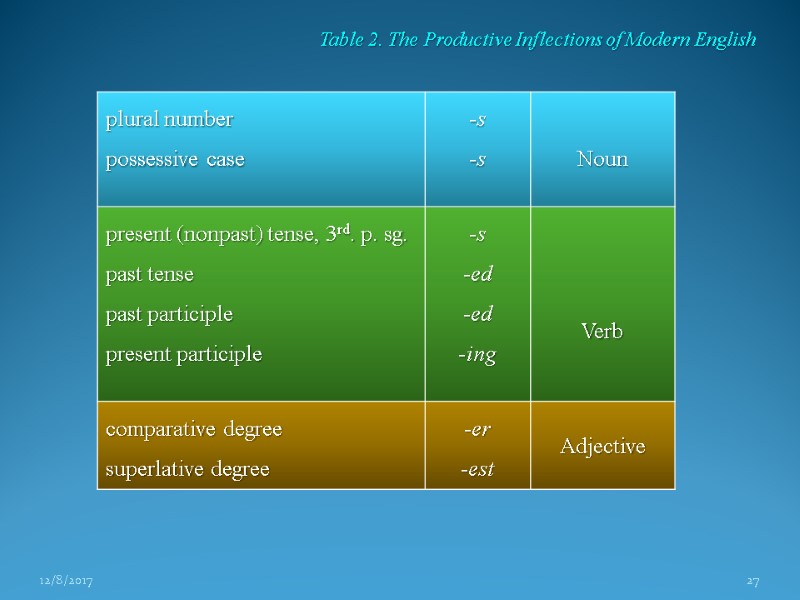
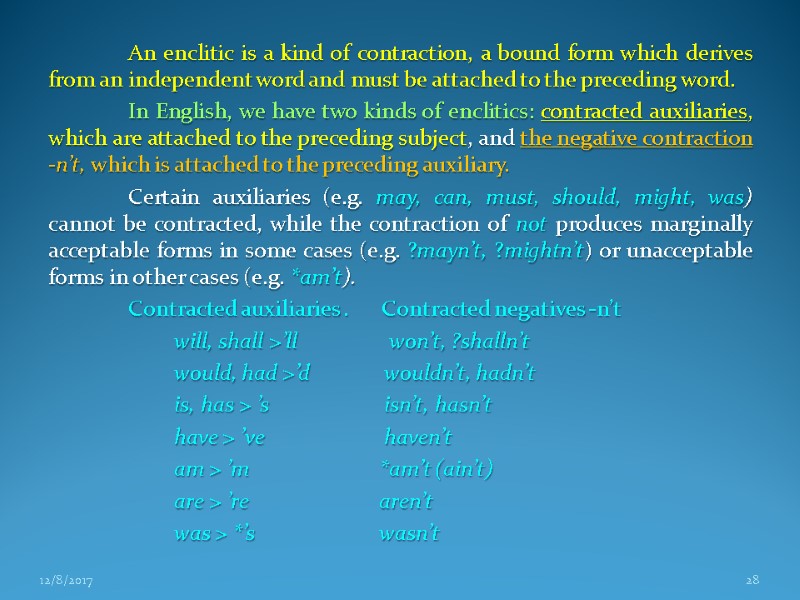
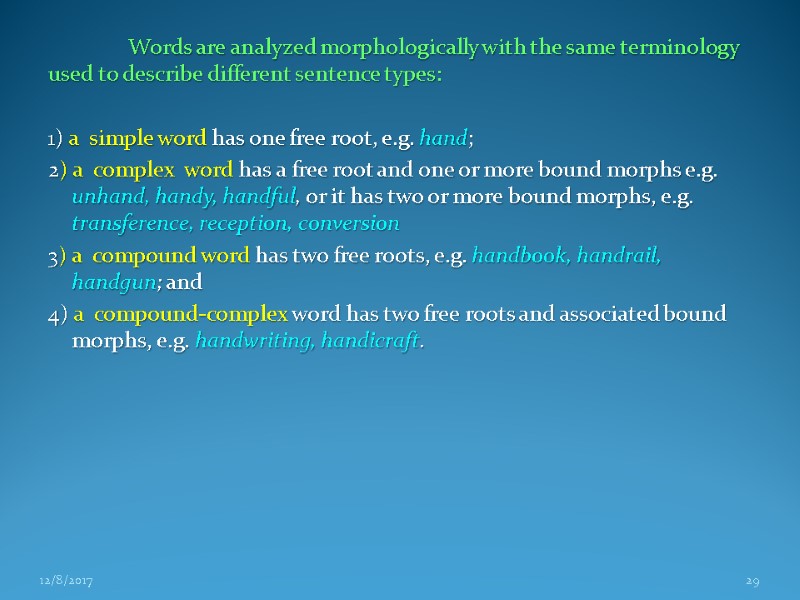
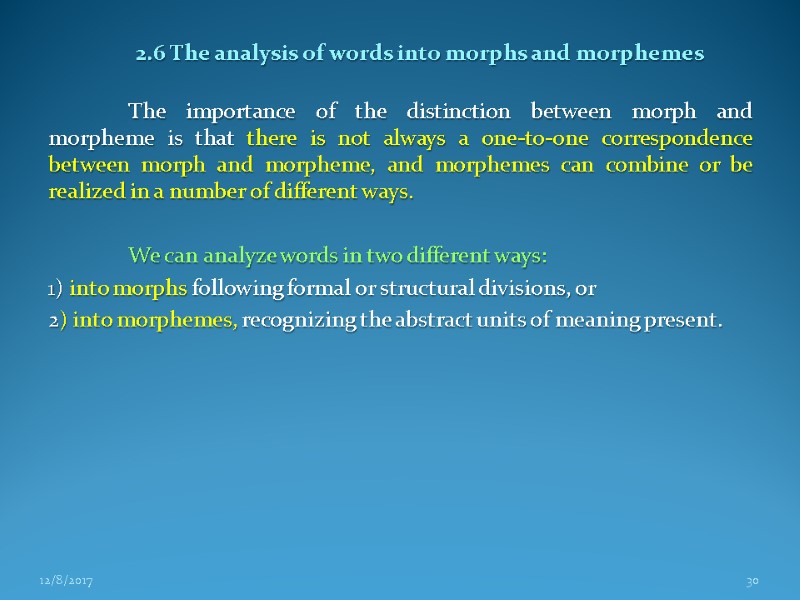
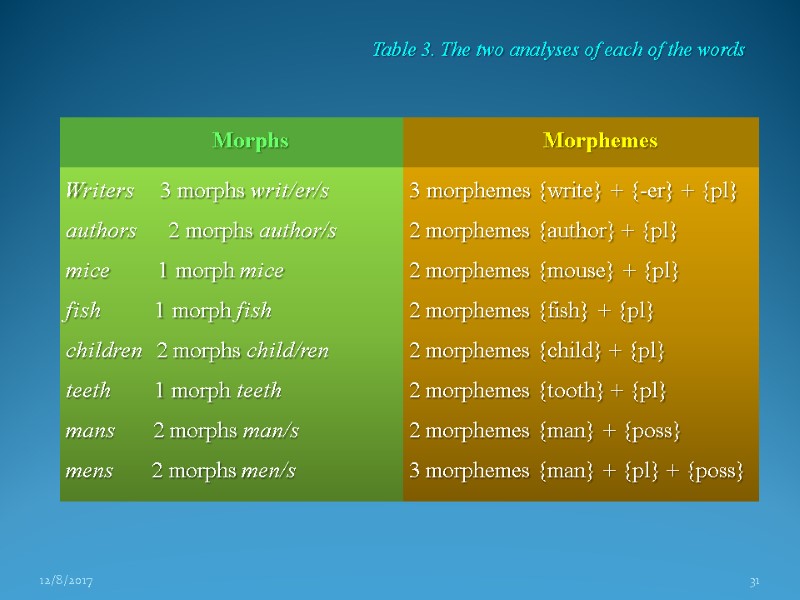
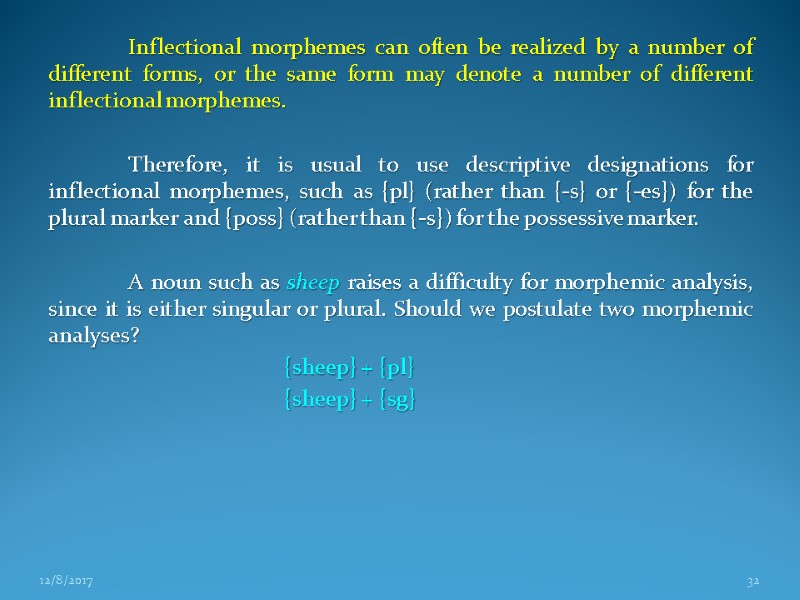
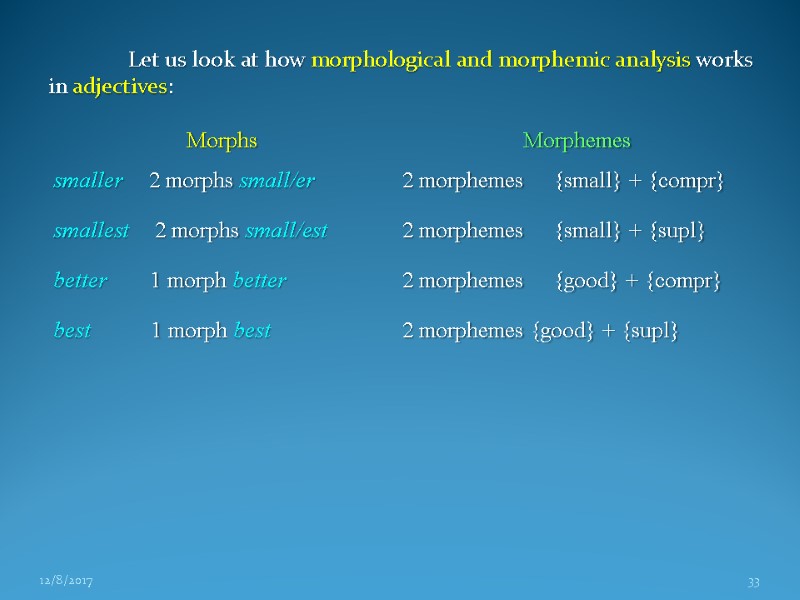
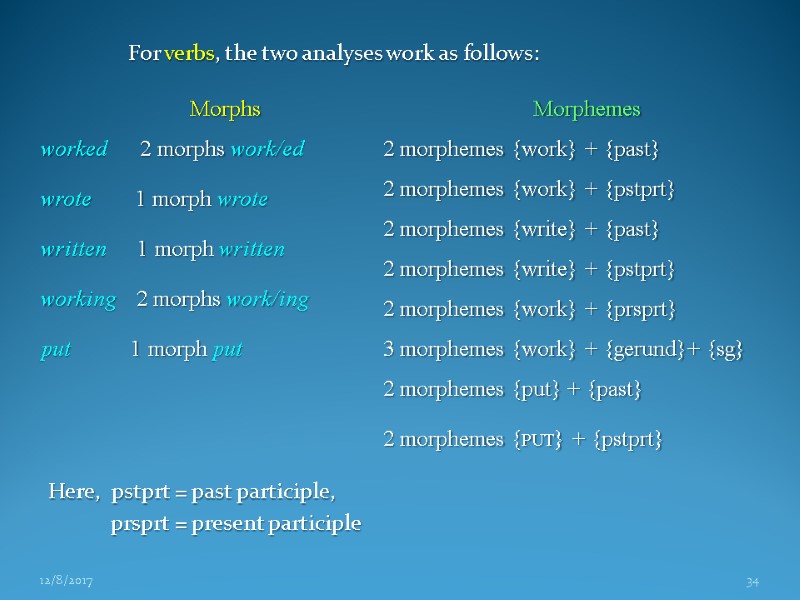
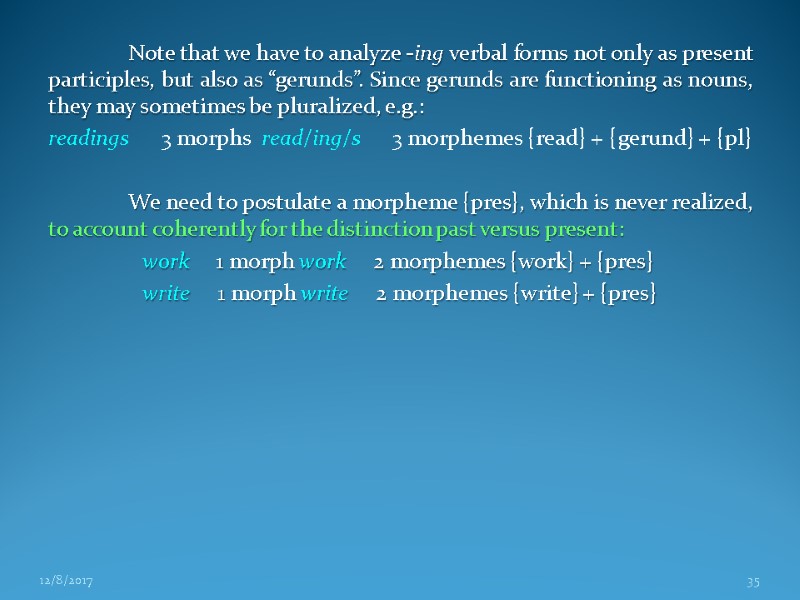
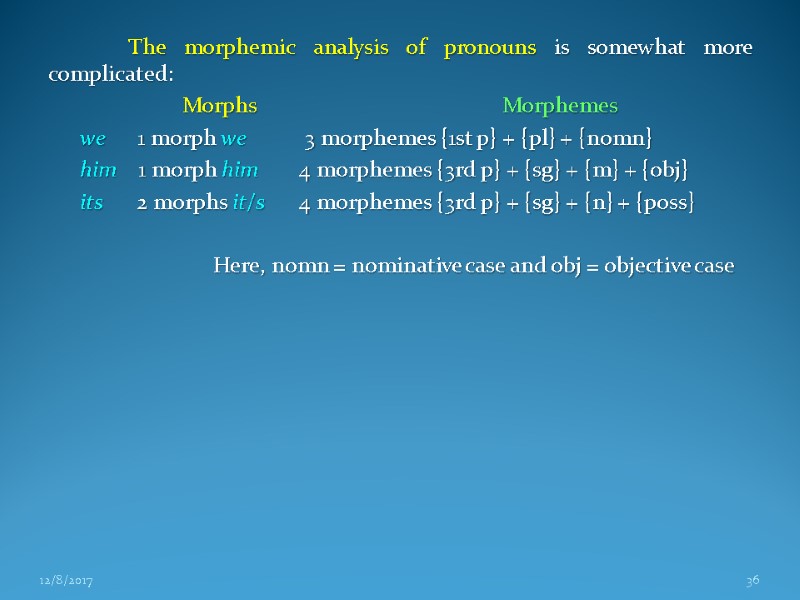
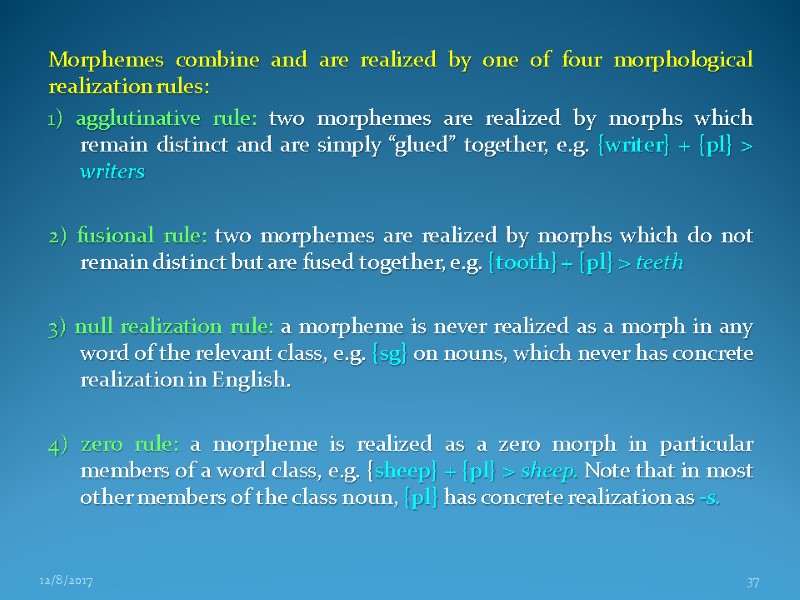
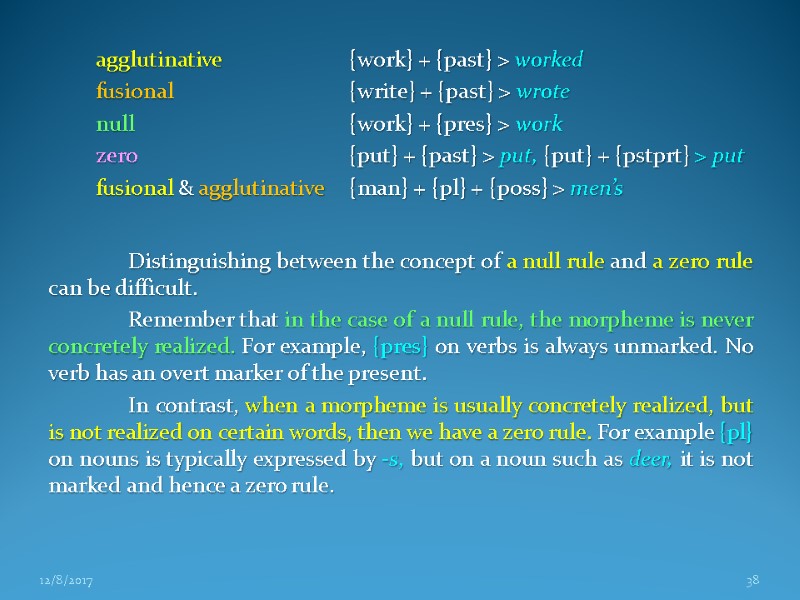
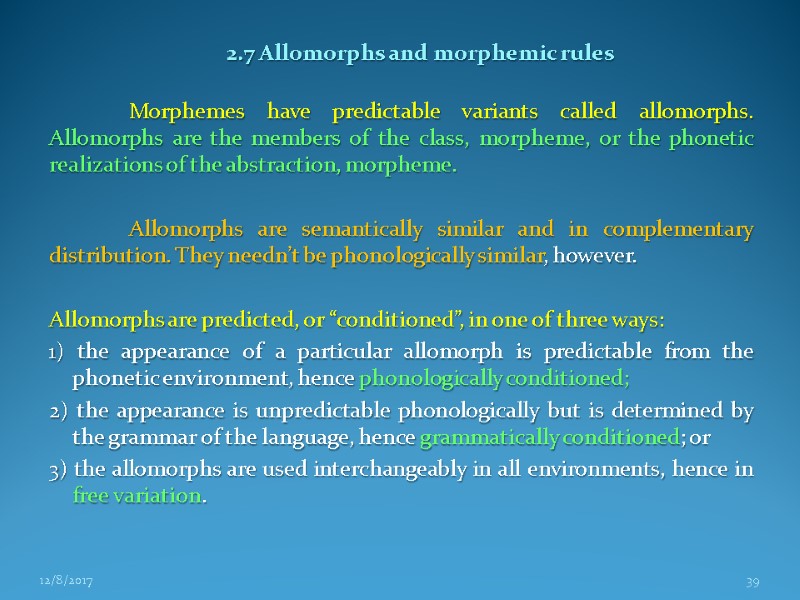
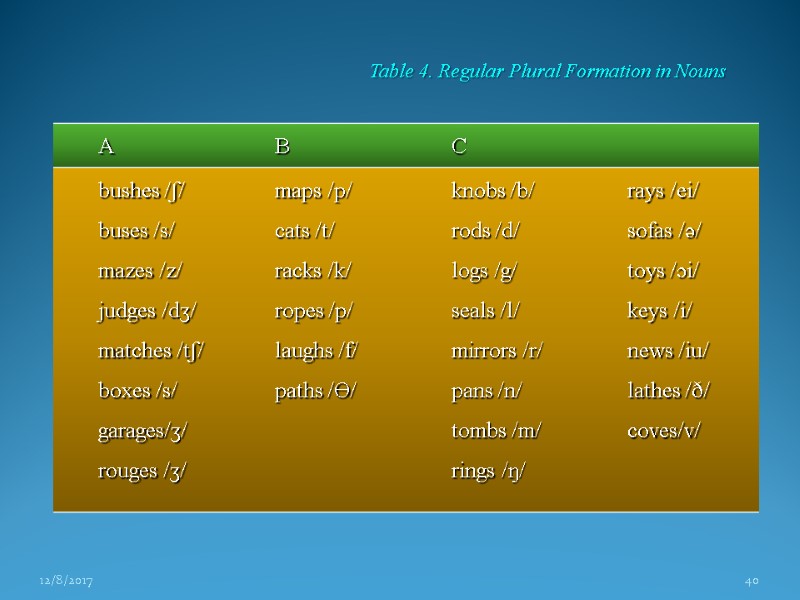
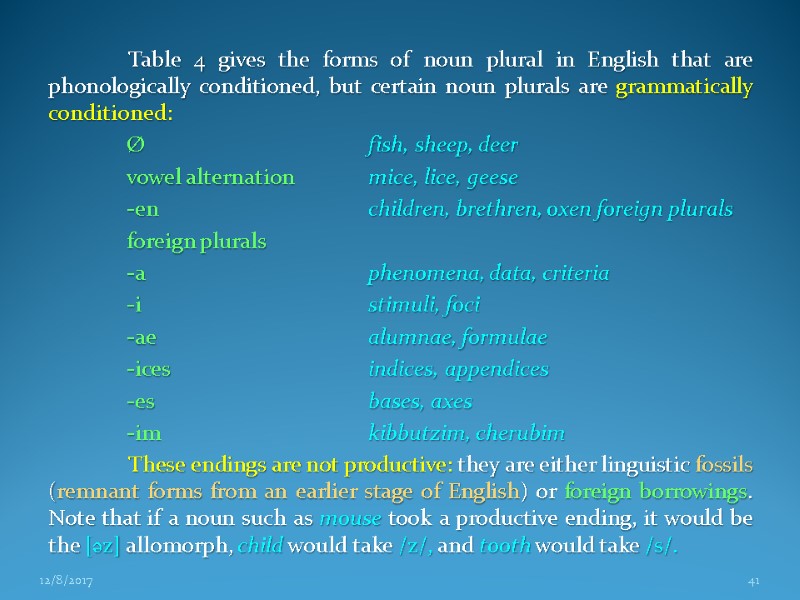
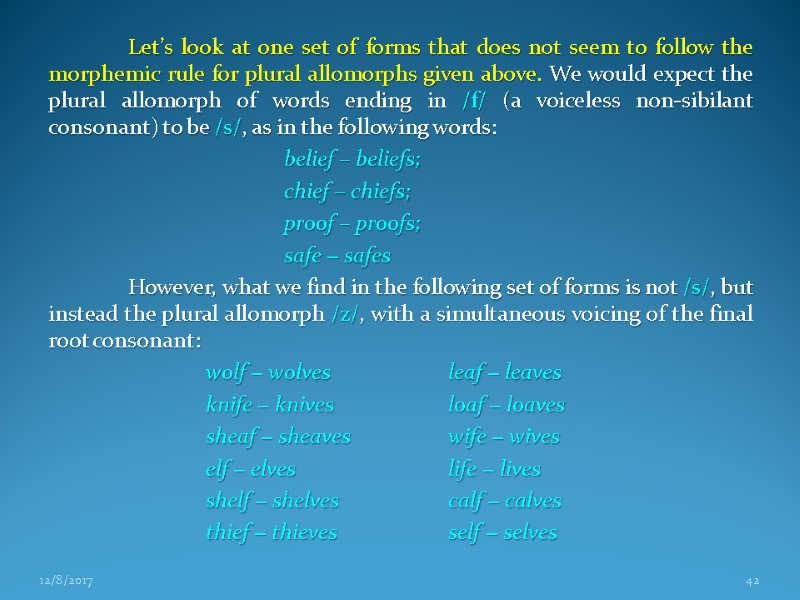
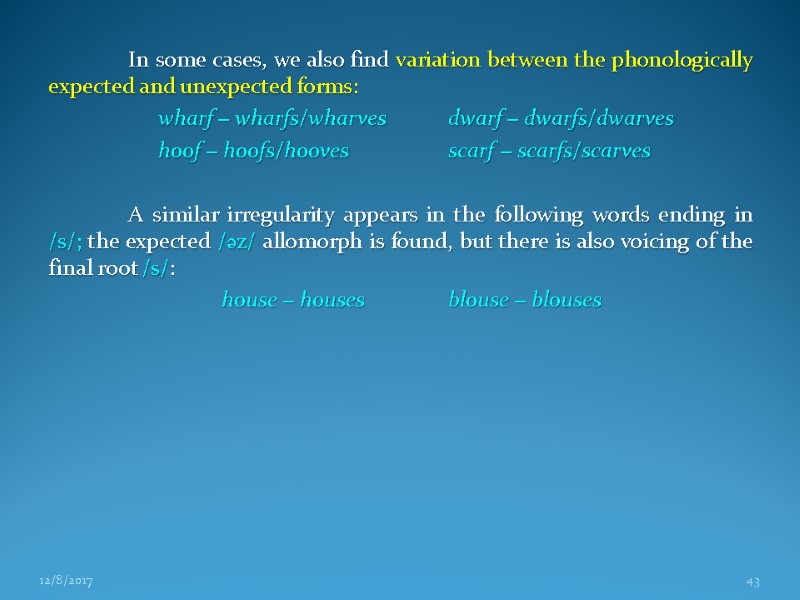
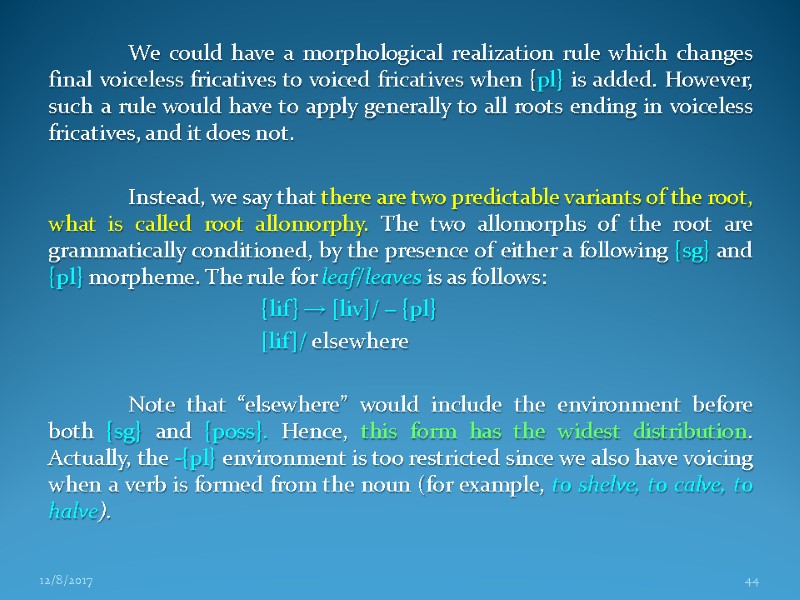
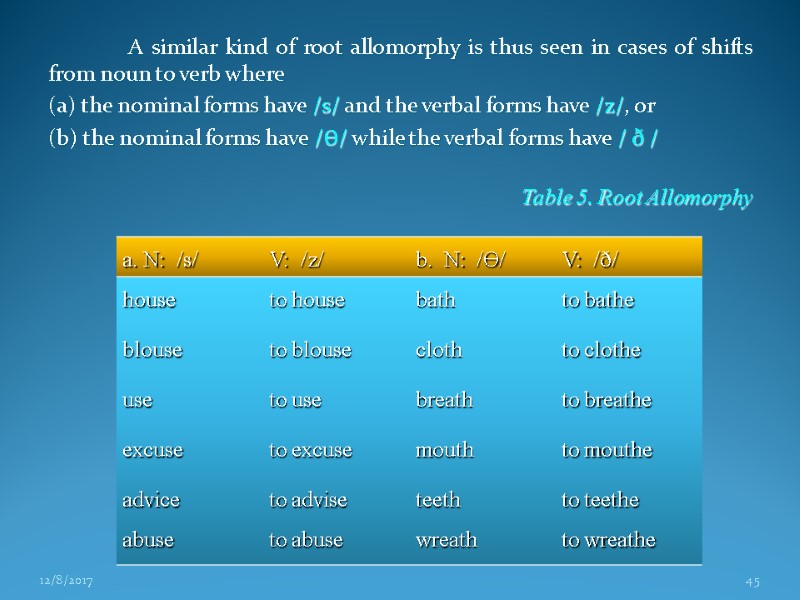
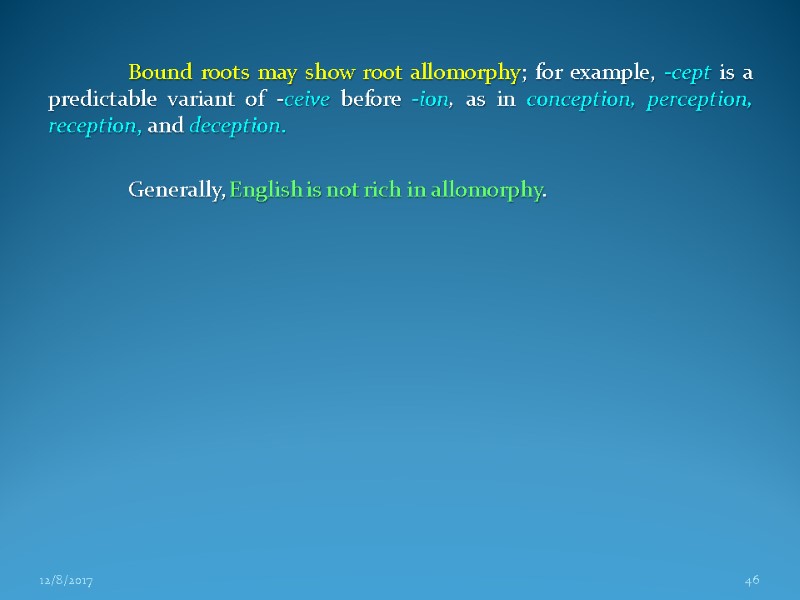

8032-lecture__2._the_internal_structure_of_words.ppt
- Количество слайдов: 47
 English lexicology Lecture 2. The International Structure of Words 2.1 Defining the word 2.2 Morphemes 2.3 morphs 2.4 Roots, bases, stems 2.5 Affixes 2.6 The analysis of words into morphs and morphemes 2.7 Allomorphs and morphemic rules 12/8/2017 1
English lexicology Lecture 2. The International Structure of Words 2.1 Defining the word 2.2 Morphemes 2.3 morphs 2.4 Roots, bases, stems 2.5 Affixes 2.6 The analysis of words into morphs and morphemes 2.7 Allomorphs and morphemic rules 12/8/2017 1
 12/8/2017 2 Figure 1 2.1 Defining the Word
12/8/2017 2 Figure 1 2.1 Defining the Word
 There are formal criteria for wordhood which all speakers use: 1. Orthographic: a word is what occurs between spaces in writing. 2. Semantic: a word has semantic coherence; it expresses a unified semantic concept. 3. Phonological: a. potential pause: a word occurs between potential pauses in speaking. Though in normal speech, we generally do not pause, we may potentially pause between words, but not in the middle of words. b. stress: a word spoken in isolation has one and only one primary stress. 4. Morphological: a word has an internal cohesion and is indivisible by other units; a word may be modified only externally by the addition of suffixes and prefixes. 5. Grammatical: words fall into particular classes. 6. Syntactic: a word has external distribution or mobility; it is moved as a unit, not in parts. 12/8/2017 3
There are formal criteria for wordhood which all speakers use: 1. Orthographic: a word is what occurs between spaces in writing. 2. Semantic: a word has semantic coherence; it expresses a unified semantic concept. 3. Phonological: a. potential pause: a word occurs between potential pauses in speaking. Though in normal speech, we generally do not pause, we may potentially pause between words, but not in the middle of words. b. stress: a word spoken in isolation has one and only one primary stress. 4. Morphological: a word has an internal cohesion and is indivisible by other units; a word may be modified only externally by the addition of suffixes and prefixes. 5. Grammatical: words fall into particular classes. 6. Syntactic: a word has external distribution or mobility; it is moved as a unit, not in parts. 12/8/2017 3
 By the criterion of orthography, supermarket and noteworthy would be considered a single word, as would hyphenated forms such as jack-of-all-trades, forget-me-not, or runner-up, while phrases such as travel agency, take out, or pins and needles must be considered as multiple words, or phrases. Yet by the second criterion, semantic unity, the words and the phrases all appear to be equally unified conceptually. The discrepancy is especially apparent if you compare supermarket with related concepts such as toy store or grocery store. In fact, the conventions of spacing between words, as well as hyphenation practices, are often quite arbitrary in English. As well as being hyphenated, forget-me-not, jack-of-all-trades, and runner-up meet the syntactic criterion of wordhood: they are moved as a single unit. 12/8/2017 4
By the criterion of orthography, supermarket and noteworthy would be considered a single word, as would hyphenated forms such as jack-of-all-trades, forget-me-not, or runner-up, while phrases such as travel agency, take out, or pins and needles must be considered as multiple words, or phrases. Yet by the second criterion, semantic unity, the words and the phrases all appear to be equally unified conceptually. The discrepancy is especially apparent if you compare supermarket with related concepts such as toy store or grocery store. In fact, the conventions of spacing between words, as well as hyphenation practices, are often quite arbitrary in English. As well as being hyphenated, forget-me-not, jack-of-all-trades, and runner-up meet the syntactic criterion of wordhood: they are moved as a single unit. 12/8/2017 4
 However, they differ in respect to the morphological criterion; while forget-me-not always behaves as a single word, with external modification (two forget-me-nots, forget-me-nots), runner-up is inconsistent, behaving as a single word when made possessive (runner-up’s), but as a phrase, that is, with internal modification, when pluralized (runners-up); jack- of-all-trades is similarly inconsistent. The third criterion, a single primary stress, would seem to be the most reliable, but even here compound adjectives such as noteworthy pose a problem: they have two primary stresses and are phonologically phrases but are treated orthographically, morphologically, and syntactically as single words. Phrasal verbs such as try out also present an interesting case. Though having many of the qualities of a phrase − internal modification occurs (tried out), material may intercede between the parts (try out the car, but also try the car out), and both try and out receive primary stress − phrasal verbs seem to express a unified semantic notion, the same as expressed in this case by the single word test. 12/8/2017 5
However, they differ in respect to the morphological criterion; while forget-me-not always behaves as a single word, with external modification (two forget-me-nots, forget-me-nots), runner-up is inconsistent, behaving as a single word when made possessive (runner-up’s), but as a phrase, that is, with internal modification, when pluralized (runners-up); jack- of-all-trades is similarly inconsistent. The third criterion, a single primary stress, would seem to be the most reliable, but even here compound adjectives such as noteworthy pose a problem: they have two primary stresses and are phonologically phrases but are treated orthographically, morphologically, and syntactically as single words. Phrasal verbs such as try out also present an interesting case. Though having many of the qualities of a phrase − internal modification occurs (tried out), material may intercede between the parts (try out the car, but also try the car out), and both try and out receive primary stress − phrasal verbs seem to express a unified semantic notion, the same as expressed in this case by the single word test. 12/8/2017 5
 Another difficulty when treating words is the term word itself, which may be used in a number of different ways: 1. It may refer to the word form, the physical unit or concrete realization, either the orthographical word (the written form) or the phonological word (the uttered or transcribed form). 2. It may refer to the lexeme, which is rather like a dictionary entry. A lexeme includes all inflected forms of a word. It is thus a kind of abstraction or class of forms and is indicated by small capitals, as in the following examples: walk − walk, walks, walked, walking run − run, runs, ran, running sing − sing, sings, sang, sung, singing 12/8/2017 6
Another difficulty when treating words is the term word itself, which may be used in a number of different ways: 1. It may refer to the word form, the physical unit or concrete realization, either the orthographical word (the written form) or the phonological word (the uttered or transcribed form). 2. It may refer to the lexeme, which is rather like a dictionary entry. A lexeme includes all inflected forms of a word. It is thus a kind of abstraction or class of forms and is indicated by small capitals, as in the following examples: walk − walk, walks, walked, walking run − run, runs, ran, running sing − sing, sings, sang, sung, singing 12/8/2017 6
 The same word form may in fact represent different lexemes: a. A homonym is a single orthographic and phonological word standing for two lexemes, as bear is either the verb or the noun. b. A homograph is a single orthographic word (but separate phonological words) standing for two lexemes, as lead is either the noun /lεd/ or the verb /lid/. c. A homophone is a single phonological word (but separate orthographical words) standing for two lexemes, as /mit/ is either the noun meat or the verb meet. The same lexeme might also have quite distinct word forms, as in the case of the definite article the, represented by /ði/ or /ðə/, or the indefinite article a/an, represented by /ei/, /ə/, /ən/, or /æn/. 12/8/2017 7
The same word form may in fact represent different lexemes: a. A homonym is a single orthographic and phonological word standing for two lexemes, as bear is either the verb or the noun. b. A homograph is a single orthographic word (but separate phonological words) standing for two lexemes, as lead is either the noun /lεd/ or the verb /lid/. c. A homophone is a single phonological word (but separate orthographical words) standing for two lexemes, as /mit/ is either the noun meat or the verb meet. The same lexeme might also have quite distinct word forms, as in the case of the definite article the, represented by /ði/ or /ðə/, or the indefinite article a/an, represented by /ei/, /ə/, /ən/, or /æn/. 12/8/2017 7
 3. Word may also refer to a morphosyntactic word (or grammatical word). A morphosyntactic word consists of a lexeme and associated grammatical meaning: I take the garbage out every week. (take + present) I took the garbage out yesterday. (take + past) I have taken the garbage out already. (take + past participle). The different morphosyntactic words are represented by different word forms (take, took, taken). But in I put the garbage out every week. (put + present) I put the garbage out yesterday. (put + past) I have put the garbage out already. (put + past participle). The different morphosyntactic words are represented by the same word form (put). 12/8/2017 8
3. Word may also refer to a morphosyntactic word (or grammatical word). A morphosyntactic word consists of a lexeme and associated grammatical meaning: I take the garbage out every week. (take + present) I took the garbage out yesterday. (take + past) I have taken the garbage out already. (take + past participle). The different morphosyntactic words are represented by different word forms (take, took, taken). But in I put the garbage out every week. (put + present) I put the garbage out yesterday. (put + past) I have put the garbage out already. (put + past participle). The different morphosyntactic words are represented by the same word form (put). 12/8/2017 8
 2.2 Morphemes A morpheme is the smallest meaningful unit in a language. The word headphones consists of the three morphemes head, phone, and -s; the word ringleader consists of three morphemes, ring, lead, and -er. Some of these morphemes may stand alone as independent words (head, phone, ring, lead), others must always be attached to some other morpheme (-er, -s). Morphemes are represented within curly braces { }. 12/8/2017 9
2.2 Morphemes A morpheme is the smallest meaningful unit in a language. The word headphones consists of the three morphemes head, phone, and -s; the word ringleader consists of three morphemes, ring, lead, and -er. Some of these morphemes may stand alone as independent words (head, phone, ring, lead), others must always be attached to some other morpheme (-er, -s). Morphemes are represented within curly braces { }. 12/8/2017 9
 12/8/2017 10 Figure 2 a morpheme characteristics it is internally indivisible; it cannot be further subdivided or analyzed into smaller meaningful units it is externally transportable it has internal stability since nothing can be interposed in a morpheme it has positional mobility or free distribution, occurring in various contexts
12/8/2017 10 Figure 2 a morpheme characteristics it is internally indivisible; it cannot be further subdivided or analyzed into smaller meaningful units it is externally transportable it has internal stability since nothing can be interposed in a morpheme it has positional mobility or free distribution, occurring in various contexts
 The morpheme refers to either a class of forms or an abstraction from the concrete forms of language. For example, the feminine morpheme is an abstraction which can be realized in a number of different ways, by -ess, as in actress, or by a personal pronoun such as she. Because morphemes are abstractions we place them within curly braces { } using capital letters for lexemes and descriptive designations for other types of morphemes. For actress, the morphemes are {ACTOR} and {f} (for {feminine]). 12/8/2017 11
The morpheme refers to either a class of forms or an abstraction from the concrete forms of language. For example, the feminine morpheme is an abstraction which can be realized in a number of different ways, by -ess, as in actress, or by a personal pronoun such as she. Because morphemes are abstractions we place them within curly braces { } using capital letters for lexemes and descriptive designations for other types of morphemes. For actress, the morphemes are {ACTOR} and {f} (for {feminine]). 12/8/2017 11
 12/8/2017 12 Figure 3. Types of Morphemes affix function inflectional Morpheme word word affix Content derivational grammatical lexical
12/8/2017 12 Figure 3. Types of Morphemes affix function inflectional Morpheme word word affix Content derivational grammatical lexical
 Lexical morphemes express lexical, or dictionary, meaning. They can be categorized into the major lexical categories, or word classes: noun, verb, adjective, or adverb; these are frequently called “content words”. They constitute open categories, to which new members can be added. Lexical morphemes are generally independent words (free roots) or parts of words (derivational affixes and bound roots). 12/8/2017 13
Lexical morphemes express lexical, or dictionary, meaning. They can be categorized into the major lexical categories, or word classes: noun, verb, adjective, or adverb; these are frequently called “content words”. They constitute open categories, to which new members can be added. Lexical morphemes are generally independent words (free roots) or parts of words (derivational affixes and bound roots). 12/8/2017 13
 Grammatical morphemes express a limited number of very common meanings or express relations within the sentence. They do not constitute open categories; they can be exhaustively listed. Their occurrence is (entirely) predictable by the grammar of the sentence because certain grammatical meanings are associated with certain lexical categories, for example, tense and voice with the verb, and number and gender with the noun. Grammatical morphemes may be parts of words (inflectional affixes) or small but independent “function words” belonging to the minor word classes: preposition, article, demonstrative, conjunction, auxiliary, and so on, e.g. of, the, that, and, may. 12/8/2017 14
Grammatical morphemes express a limited number of very common meanings or express relations within the sentence. They do not constitute open categories; they can be exhaustively listed. Their occurrence is (entirely) predictable by the grammar of the sentence because certain grammatical meanings are associated with certain lexical categories, for example, tense and voice with the verb, and number and gender with the noun. Grammatical morphemes may be parts of words (inflectional affixes) or small but independent “function words” belonging to the minor word classes: preposition, article, demonstrative, conjunction, auxiliary, and so on, e.g. of, the, that, and, may. 12/8/2017 14
 2.3. Morphs The level of the morph is the concrete realization of a morpheme, or the actual segment of a word as it is spoken or pronounced. Morphs are represented by phonetic forms. We must introduce the concept of the morph distinct from the morpheme because sometimes although we know that a morpheme exists, it has no concrete realization (i.e, it is silent and has no spoken or written form). In such cases, we speak of a zero morph, one which has no phonetic or overt realization. There is no equivalent on the level of the phoneme. For example, plural fish consists of the morphemes {fish} + {pl}, but the plural morpheme has no concrete realization (i.e. the singular and plural forms of fish are both pronounced /fiʃ/). 12/8/2017 15
2.3. Morphs The level of the morph is the concrete realization of a morpheme, or the actual segment of a word as it is spoken or pronounced. Morphs are represented by phonetic forms. We must introduce the concept of the morph distinct from the morpheme because sometimes although we know that a morpheme exists, it has no concrete realization (i.e, it is silent and has no spoken or written form). In such cases, we speak of a zero morph, one which has no phonetic or overt realization. There is no equivalent on the level of the phoneme. For example, plural fish consists of the morphemes {fish} + {pl}, but the plural morpheme has no concrete realization (i.e. the singular and plural forms of fish are both pronounced /fiʃ/). 12/8/2017 15
 Another example of a zero morph is the past tense of let; although the past consists of the morpheme {let} plus the morpheme {past}, the past tense morpheme has no concrete expression (i.e. the present and past forms of let are both pronounced /lɛt/). 12/8/2017 16
Another example of a zero morph is the past tense of let; although the past consists of the morpheme {let} plus the morpheme {past}, the past tense morpheme has no concrete expression (i.e. the present and past forms of let are both pronounced /lɛt/). 12/8/2017 16
 12/8/2017 17 function Morph word affix Free (root) bound Figure 4. Types of Morphs content bound root enclitic prefix suffix infectional auxilary negative word derivational derivational
12/8/2017 17 function Morph word affix Free (root) bound Figure 4. Types of Morphs content bound root enclitic prefix suffix infectional auxilary negative word derivational derivational
 A free morph may stand alone as a word, while a bound morph may not; it must always be attached to another morph. A free morph is always a root. That is, it carries the principal lexical or grammatical meaning. It occupies the position where there is greatest potential for substitution; it may attach to other free or bound morphemes. 12/8/2017 18
A free morph may stand alone as a word, while a bound morph may not; it must always be attached to another morph. A free morph is always a root. That is, it carries the principal lexical or grammatical meaning. It occupies the position where there is greatest potential for substitution; it may attach to other free or bound morphemes. 12/8/2017 18
 2.4 Roots, Bases, Stems A root is often distinguished both from a base (a root plus associated derivational affixes, to which derivational affixes are added) and from a stem (a root plus associated derivational affixes, to which inflectional affixes are added). Thus, in the word engagement, gage is the root, engage is the base, and engagement is the stem. unavoidably overgrown altruistic decoration provocative disheartened reclassify heterosexuality upbringing realization 12/8/2017 19
2.4 Roots, Bases, Stems A root is often distinguished both from a base (a root plus associated derivational affixes, to which derivational affixes are added) and from a stem (a root plus associated derivational affixes, to which inflectional affixes are added). Thus, in the word engagement, gage is the root, engage is the base, and engagement is the stem. unavoidably overgrown altruistic decoration provocative disheartened reclassify heterosexuality upbringing realization 12/8/2017 19
 Roots are also occasionally bound morphs (called bound roots). Bound roots are often foreign borrowings that were free in the source language, but not free in English: -vert convert, revert, subvert, introvert, pervert -mit transmit, commit, remit, admit, omit, submit -ceive conceive, perceive, receive, deceive -fer transfer, refer, prefer, defer, confer However -vert, -mit, -ceive, and -fer cannot stand alone as independent words, and we would also find it very difficult to state the meaning of any of these roots, unless we know Latin, from which these words derive: -vert is from Latin vertere meaning ‘to turn, -mit is from Latin mittere meaning ‘to send’, -ceive is from Latin capere meaning ‘to seize’, and -fer is from Latin ferre meaning ‘to bring’. 12/8/2017 20
Roots are also occasionally bound morphs (called bound roots). Bound roots are often foreign borrowings that were free in the source language, but not free in English: -vert convert, revert, subvert, introvert, pervert -mit transmit, commit, remit, admit, omit, submit -ceive conceive, perceive, receive, deceive -fer transfer, refer, prefer, defer, confer However -vert, -mit, -ceive, and -fer cannot stand alone as independent words, and we would also find it very difficult to state the meaning of any of these roots, unless we know Latin, from which these words derive: -vert is from Latin vertere meaning ‘to turn, -mit is from Latin mittere meaning ‘to send’, -ceive is from Latin capere meaning ‘to seize’, and -fer is from Latin ferre meaning ‘to bring’. 12/8/2017 20
 Bound roots may also be native English, as with -kempt (< unkempt) and -couth (< uncouth), where the positive form no longer exists. You could say that the bound roots have a meaning only if you know their history, or etymology. For this reason, they have been termed etymemes. 12/8/2017 21
Bound roots may also be native English, as with -kempt (< unkempt) and -couth (< uncouth), where the positive form no longer exists. You could say that the bound roots have a meaning only if you know their history, or etymology. For this reason, they have been termed etymemes. 12/8/2017 21
 2.5. Affixes Unlike a root, an affix does not carry the core meaning. It is always bound to a root. It occupies a position where there is limited potential for substitution; that is, a particular affix will attach to only certain roots. English has two kinds of affixes, prefixes, which attach to the beginnings of roots, and suffixes, which attach to the end of roots. Some languages regularly use infixes, which are inserted in the middle of words. In Modern English, infixes are used only for humorous purposes, as in im-bloody-possible or abso-blooming-lutely. While it might initially be tempting to analyze the vowel alternation indicating plural (as in man, men) or past tense (as in sing, sang) in Modern English as a kind of infix, the vowels are not added or inserted but actually replace the existing vowels. 12/8/2017 22
2.5. Affixes Unlike a root, an affix does not carry the core meaning. It is always bound to a root. It occupies a position where there is limited potential for substitution; that is, a particular affix will attach to only certain roots. English has two kinds of affixes, prefixes, which attach to the beginnings of roots, and suffixes, which attach to the end of roots. Some languages regularly use infixes, which are inserted in the middle of words. In Modern English, infixes are used only for humorous purposes, as in im-bloody-possible or abso-blooming-lutely. While it might initially be tempting to analyze the vowel alternation indicating plural (as in man, men) or past tense (as in sing, sang) in Modern English as a kind of infix, the vowels are not added or inserted but actually replace the existing vowels. 12/8/2017 22
 Affixes may be of two types, derivational or inflectional, which have very different characteristics. A derivational affix in English is either a prefix or a suffix. There may be more than one derivational affix per word. A particular derivational affix may attach to only a limited number of roots; which roots it attaches to is not predictable by rule, but highly idiosyncratic and must be learned. A derivational affix has one of two functions: 1) to convert one part of speech to another (in which case, it is class changing) and/or 2) to change the meaning of the root (in which case, it is class maintaining). Such affixes function, then, in word formation and are important in the creation of new lexemes in the language. They always precede an inflectional affix. 12/8/2017 23
Affixes may be of two types, derivational or inflectional, which have very different characteristics. A derivational affix in English is either a prefix or a suffix. There may be more than one derivational affix per word. A particular derivational affix may attach to only a limited number of roots; which roots it attaches to is not predictable by rule, but highly idiosyncratic and must be learned. A derivational affix has one of two functions: 1) to convert one part of speech to another (in which case, it is class changing) and/or 2) to change the meaning of the root (in which case, it is class maintaining). Such affixes function, then, in word formation and are important in the creation of new lexemes in the language. They always precede an inflectional affix. 12/8/2017 23
 An inflectional affix in English is always a suffix. A particular inflectional affix attaches to all (or most) members of a certain word class. The function of inflectional affixes is to indicate grammatical meaning, such as tense or number. Because grammatical meaning is relevant outside the word, to the grammar of the entire sentence, inflectional affixes always occur last, following the root and any derivational affixes, which are central to the meaning or class of the root. 12/8/2017 24
An inflectional affix in English is always a suffix. A particular inflectional affix attaches to all (or most) members of a certain word class. The function of inflectional affixes is to indicate grammatical meaning, such as tense or number. Because grammatical meaning is relevant outside the word, to the grammar of the entire sentence, inflectional affixes always occur last, following the root and any derivational affixes, which are central to the meaning or class of the root. 12/8/2017 24
 12/8/2017 25 Table 1. Derivational vs. Inflectional Affixes in English
12/8/2017 25 Table 1. Derivational vs. Inflectional Affixes in English
 A distinction can be made between productive inflections, which would attach to any new word entering the language to express a particular grammatical category, and nonproductive, or remnant, inflections, which are found on select members of a class, but would never be added to a new word. There are only eight productive inflections in Modern English, as shown in Table 2. Some examples of nonproductive inflections are the plural vowel alternation tooth-teeth; the -most superlative of foremost; the -en past participle of write-written; or the past tense vowel alternation of ring-rang. 12/8/2017 26
A distinction can be made between productive inflections, which would attach to any new word entering the language to express a particular grammatical category, and nonproductive, or remnant, inflections, which are found on select members of a class, but would never be added to a new word. There are only eight productive inflections in Modern English, as shown in Table 2. Some examples of nonproductive inflections are the plural vowel alternation tooth-teeth; the -most superlative of foremost; the -en past participle of write-written; or the past tense vowel alternation of ring-rang. 12/8/2017 26
 12/8/2017 27 Table 2. The Productive Inflections of Modern English
12/8/2017 27 Table 2. The Productive Inflections of Modern English
 An enclitic is a kind of contraction, a bound form which derives from an independent word and must be attached to the preceding word. In English, we have two kinds of enclitics: contracted auxiliaries, which are attached to the preceding subject, and the negative contraction -n’t, which is attached to the preceding auxiliary. Certain auxiliaries (e.g. may, can, must, should, might, was) cannot be contracted, while the contraction of not produces marginally acceptable forms in some cases (e.g. ?mayn’t, ?mightn’t) or unacceptable forms in other cases (e.g. *am’t). Contracted auxiliaries . Contracted negatives -n’t will, shall >’ll won’t, ?shalln’t would, had >’d wouldn’t, hadn’t is, has > ’s isn’t, hasn’t have > ’ve haven’t am > ’m *am’t (ain’t) are > ’re aren’t was > *’s wasn’t 12/8/2017 28
An enclitic is a kind of contraction, a bound form which derives from an independent word and must be attached to the preceding word. In English, we have two kinds of enclitics: contracted auxiliaries, which are attached to the preceding subject, and the negative contraction -n’t, which is attached to the preceding auxiliary. Certain auxiliaries (e.g. may, can, must, should, might, was) cannot be contracted, while the contraction of not produces marginally acceptable forms in some cases (e.g. ?mayn’t, ?mightn’t) or unacceptable forms in other cases (e.g. *am’t). Contracted auxiliaries . Contracted negatives -n’t will, shall >’ll won’t, ?shalln’t would, had >’d wouldn’t, hadn’t is, has > ’s isn’t, hasn’t have > ’ve haven’t am > ’m *am’t (ain’t) are > ’re aren’t was > *’s wasn’t 12/8/2017 28
 Words are analyzed morphologically with the same terminology used to describe different sentence types: 1) a simple word has one free root, e.g. hand; 2) a complex word has a free root and one or more bound morphs e.g. unhand, handy, handful, or it has two or more bound morphs, e.g. transference, reception, conversion 3) a compound word has two free roots, e.g. handbook, handrail, handgun; and 4) a compound-complex word has two free roots and associated bound morphs, e.g. handwriting, handicraft. 12/8/2017 29
Words are analyzed morphologically with the same terminology used to describe different sentence types: 1) a simple word has one free root, e.g. hand; 2) a complex word has a free root and one or more bound morphs e.g. unhand, handy, handful, or it has two or more bound morphs, e.g. transference, reception, conversion 3) a compound word has two free roots, e.g. handbook, handrail, handgun; and 4) a compound-complex word has two free roots and associated bound morphs, e.g. handwriting, handicraft. 12/8/2017 29
 2.6 The analysis of words into morphs and morphemes The importance of the distinction between morph and morpheme is that there is not always a one-to-one correspondence between morph and morpheme, and morphemes can combine or be realized in a number of different ways. We can analyze words in two different ways: 1) into morphs following formal or structural divisions, or 2) into morphemes, recognizing the abstract units of meaning present. 12/8/2017 30
2.6 The analysis of words into morphs and morphemes The importance of the distinction between morph and morpheme is that there is not always a one-to-one correspondence between morph and morpheme, and morphemes can combine or be realized in a number of different ways. We can analyze words in two different ways: 1) into morphs following formal or structural divisions, or 2) into morphemes, recognizing the abstract units of meaning present. 12/8/2017 30
 12/8/2017 31 Table 3. The two analyses of each of the words
12/8/2017 31 Table 3. The two analyses of each of the words
 Inflectional morphemes can often be realized by a number of different forms, or the same form may denote a number of different inflectional morphemes. Therefore, it is usual to use descriptive designations for inflectional morphemes, such as {pl} (rather than {-s} or {-es}) for the plural marker and {poss} (rather than {-s}) for the possessive marker. A noun such as sheep raises a difficulty for morphemic analysis, since it is either singular or plural. Should we postulate two morphemic analyses? {sheep} + {pl} {sheep} + {sg} 12/8/2017 32
Inflectional morphemes can often be realized by a number of different forms, or the same form may denote a number of different inflectional morphemes. Therefore, it is usual to use descriptive designations for inflectional morphemes, such as {pl} (rather than {-s} or {-es}) for the plural marker and {poss} (rather than {-s}) for the possessive marker. A noun such as sheep raises a difficulty for morphemic analysis, since it is either singular or plural. Should we postulate two morphemic analyses? {sheep} + {pl} {sheep} + {sg} 12/8/2017 32
 Let us look at how morphological and morphemic analysis works in adjectives: 12/8/2017 33
Let us look at how morphological and morphemic analysis works in adjectives: 12/8/2017 33
 For verbs, the two analyses work as follows: Here, pstprt = past participle, prsprt = present participle 12/8/2017 34
For verbs, the two analyses work as follows: Here, pstprt = past participle, prsprt = present participle 12/8/2017 34
 Note that we have to analyze -ing verbal forms not only as present participles, but also as “gerunds”. Since gerunds are functioning as nouns, they may sometimes be pluralized, e.g.: readings 3 morphs read/ing/s 3 morphemes {read} + {gerund} + {pl} We need to postulate a morpheme {pres}, which is never realized, to account coherently for the distinction past versus present: work 1 morph work 2 morphemes {work} + {pres} write 1 morph write 2 morphemes {write} + {pres} 12/8/2017 35
Note that we have to analyze -ing verbal forms not only as present participles, but also as “gerunds”. Since gerunds are functioning as nouns, they may sometimes be pluralized, e.g.: readings 3 morphs read/ing/s 3 morphemes {read} + {gerund} + {pl} We need to postulate a morpheme {pres}, which is never realized, to account coherently for the distinction past versus present: work 1 morph work 2 morphemes {work} + {pres} write 1 morph write 2 morphemes {write} + {pres} 12/8/2017 35
 The morphemic analysis of pronouns is somewhat more complicated: Morphs Morphemes we 1 morph we 3 morphemes {1st p} + {pl} + {nomn} him 1 morph him 4 morphemes {3rd p} + {sg} + {m} + {obj} its 2 morphs it/s 4 morphemes {3rd p} + {sg} + {n} + {poss} Here, nomn = nominative case and obj = objective case 12/8/2017 36
The morphemic analysis of pronouns is somewhat more complicated: Morphs Morphemes we 1 morph we 3 morphemes {1st p} + {pl} + {nomn} him 1 morph him 4 morphemes {3rd p} + {sg} + {m} + {obj} its 2 morphs it/s 4 morphemes {3rd p} + {sg} + {n} + {poss} Here, nomn = nominative case and obj = objective case 12/8/2017 36
 Morphemes combine and are realized by one of four morphological realization rules: 1) agglutinative rule: two morphemes are realized by morphs which remain distinct and are simply “glued” together, e.g. {writer} + {pl} > writers 2) fusional rule: two morphemes are realized by morphs which do not remain distinct but are fused together, e.g. {tooth} + {pl} > teeth 3) null realization rule: a morpheme is never realized as a morph in any word of the relevant class, e.g. {sg} on nouns, which never has concrete realization in English. 4) zero rule: a morpheme is realized as a zero morph in particular members of a word class, e.g. {sheep} + {pl} > sheep. Note that in most other members of the class noun, {pl} has concrete realization as -s. 12/8/2017 37
Morphemes combine and are realized by one of four morphological realization rules: 1) agglutinative rule: two morphemes are realized by morphs which remain distinct and are simply “glued” together, e.g. {writer} + {pl} > writers 2) fusional rule: two morphemes are realized by morphs which do not remain distinct but are fused together, e.g. {tooth} + {pl} > teeth 3) null realization rule: a morpheme is never realized as a morph in any word of the relevant class, e.g. {sg} on nouns, which never has concrete realization in English. 4) zero rule: a morpheme is realized as a zero morph in particular members of a word class, e.g. {sheep} + {pl} > sheep. Note that in most other members of the class noun, {pl} has concrete realization as -s. 12/8/2017 37
 agglutinative {work} + {past} > worked fusional {write} + {past} > wrote null {work} + {pres} > work zero {put} + {past} > put, {put} + {pstprt} > put fusional & agglutinative {man} + {pl} + {poss} > men’s Distinguishing between the concept of a null rule and a zero rule can be difficult. Remember that in the case of a null rule, the morpheme is never concretely realized. For example, {pres} on verbs is always unmarked. No verb has an overt marker of the present. In contrast, when a morpheme is usually concretely realized, but is not realized on certain words, then we have a zero rule. For example {pl} on nouns is typically expressed by -s, but on a noun such as deer, it is not marked and hence a zero rule. 12/8/2017 38
agglutinative {work} + {past} > worked fusional {write} + {past} > wrote null {work} + {pres} > work zero {put} + {past} > put, {put} + {pstprt} > put fusional & agglutinative {man} + {pl} + {poss} > men’s Distinguishing between the concept of a null rule and a zero rule can be difficult. Remember that in the case of a null rule, the morpheme is never concretely realized. For example, {pres} on verbs is always unmarked. No verb has an overt marker of the present. In contrast, when a morpheme is usually concretely realized, but is not realized on certain words, then we have a zero rule. For example {pl} on nouns is typically expressed by -s, but on a noun such as deer, it is not marked and hence a zero rule. 12/8/2017 38
 2.7 Allomorphs and morphemic rules Morphemes have predictable variants called allomorphs. Allomorphs are the members of the class, morpheme, or the phonetic realizations of the abstraction, morpheme. Allomorphs are semantically similar and in complementary distribution. They needn’t be phonologically similar, however. Allomorphs are predicted, or “conditioned”, in one of three ways: 1) the appearance of a particular allomorph is predictable from the phonetic environment, hence phonologically conditioned; 2) the appearance is unpredictable phonologically but is determined by the grammar of the language, hence grammatically conditioned; or 3) the allomorphs are used interchangeably in all environments, hence in free variation. 12/8/2017 39
2.7 Allomorphs and morphemic rules Morphemes have predictable variants called allomorphs. Allomorphs are the members of the class, morpheme, or the phonetic realizations of the abstraction, morpheme. Allomorphs are semantically similar and in complementary distribution. They needn’t be phonologically similar, however. Allomorphs are predicted, or “conditioned”, in one of three ways: 1) the appearance of a particular allomorph is predictable from the phonetic environment, hence phonologically conditioned; 2) the appearance is unpredictable phonologically but is determined by the grammar of the language, hence grammatically conditioned; or 3) the allomorphs are used interchangeably in all environments, hence in free variation. 12/8/2017 39
 12/8/2017 40 Table 4. Regular Plural Formation in Nouns
12/8/2017 40 Table 4. Regular Plural Formation in Nouns
 Table 4 gives the forms of noun plural in English that are phonologically conditioned, but certain noun plurals are grammatically conditioned: Ø fish, sheep, deer vowel alternation mice, lice, geese -en children, brethren, oxen foreign plurals foreign plurals -a phenomena, data, criteria -i stimuli, foci -аe alumnae, formulae -ices indices, appendices -es bases, axes -im kibbutzim, cherubim These endings are not productive: they are either linguistic fossils (remnant forms from an earlier stage of English) or foreign borrowings. Note that if a noun such as mouse took a productive ending, it would be the [əz] allomorph, child would take /z/, and tooth would take /s/. 12/8/2017 41
Table 4 gives the forms of noun plural in English that are phonologically conditioned, but certain noun plurals are grammatically conditioned: Ø fish, sheep, deer vowel alternation mice, lice, geese -en children, brethren, oxen foreign plurals foreign plurals -a phenomena, data, criteria -i stimuli, foci -аe alumnae, formulae -ices indices, appendices -es bases, axes -im kibbutzim, cherubim These endings are not productive: they are either linguistic fossils (remnant forms from an earlier stage of English) or foreign borrowings. Note that if a noun such as mouse took a productive ending, it would be the [əz] allomorph, child would take /z/, and tooth would take /s/. 12/8/2017 41
 Let’s look at one set of forms that does not seem to follow the morphemic rule for plural allomorphs given above. We would expect the plural allomorph of words ending in /f/ (a voiceless non-sibilant consonant) to be /s/, as in the following words: belief – beliefs; chief – chiefs; proof – proofs; safe − safes However, what we find in the following set of forms is not /s/, but instead the plural allomorph /z/, with a simultaneous voicing of the final root consonant: wolf − wolves leaf − leaves knife − knives loaf − loaves sheaf − sheaves wife − wives elf − elves life − lives shelf − shelves calf − calves thief − thieves self − selves 12/8/2017 42
Let’s look at one set of forms that does not seem to follow the morphemic rule for plural allomorphs given above. We would expect the plural allomorph of words ending in /f/ (a voiceless non-sibilant consonant) to be /s/, as in the following words: belief – beliefs; chief – chiefs; proof – proofs; safe − safes However, what we find in the following set of forms is not /s/, but instead the plural allomorph /z/, with a simultaneous voicing of the final root consonant: wolf − wolves leaf − leaves knife − knives loaf − loaves sheaf − sheaves wife − wives elf − elves life − lives shelf − shelves calf − calves thief − thieves self − selves 12/8/2017 42
 In some cases, we also find variation between the phonologically expected and unexpected forms: wharf − wharfs/wharves dwarf − dwarfs/dwarves hoof − hoofs/hooves scarf − scarfs/scarves A similar irregularity appears in the following words ending in /s/; the expected /əz/ allomorph is found, but there is also voicing of the final root /s/: house − houses blouse − blouses 12/8/2017 43
In some cases, we also find variation between the phonologically expected and unexpected forms: wharf − wharfs/wharves dwarf − dwarfs/dwarves hoof − hoofs/hooves scarf − scarfs/scarves A similar irregularity appears in the following words ending in /s/; the expected /əz/ allomorph is found, but there is also voicing of the final root /s/: house − houses blouse − blouses 12/8/2017 43
 We could have a morphological realization rule which changes final voiceless fricatives to voiced fricatives when {pl} is added. However, such a rule would have to apply generally to all roots ending in voiceless fricatives, and it does not. Instead, we say that there are two predictable variants of the root, what is called root allomorphy. The two allomorphs of the root are grammatically conditioned, by the presence of either a following {sg} and {pl} morpheme. The rule for leaf/leaves is as follows: {lif} → [liv]/ − {pl} [lif]/ elsewhere Note that “elsewhere” would include the environment before both {sg} and {poss}. Hence, this form has the widest distribution. Actually, the -{pl} environment is too restricted since we also have voicing when a verb is formed from the noun (for example, to shelve, to calve, to halve). 12/8/2017 44
We could have a morphological realization rule which changes final voiceless fricatives to voiced fricatives when {pl} is added. However, such a rule would have to apply generally to all roots ending in voiceless fricatives, and it does not. Instead, we say that there are two predictable variants of the root, what is called root allomorphy. The two allomorphs of the root are grammatically conditioned, by the presence of either a following {sg} and {pl} morpheme. The rule for leaf/leaves is as follows: {lif} → [liv]/ − {pl} [lif]/ elsewhere Note that “elsewhere” would include the environment before both {sg} and {poss}. Hence, this form has the widest distribution. Actually, the -{pl} environment is too restricted since we also have voicing when a verb is formed from the noun (for example, to shelve, to calve, to halve). 12/8/2017 44
 A similar kind of root allomorphy is thus seen in cases of shifts from noun to verb where (a) the nominal forms have /s/ and the verbal forms have /z/, or (b) the nominal forms have /Ɵ/ while the verbal forms have / ð / Table 5. Root Allomorphy 12/8/2017 45
A similar kind of root allomorphy is thus seen in cases of shifts from noun to verb where (a) the nominal forms have /s/ and the verbal forms have /z/, or (b) the nominal forms have /Ɵ/ while the verbal forms have / ð / Table 5. Root Allomorphy 12/8/2017 45
 Bound roots may show root allomorphy; for example, -cept is a predictable variant of -ceive before -ion, as in conception, perception, reception, and deception. Generally, English is not rich in allomorphy. 12/8/2017 46
Bound roots may show root allomorphy; for example, -cept is a predictable variant of -ceive before -ion, as in conception, perception, reception, and deception. Generally, English is not rich in allomorphy. 12/8/2017 46
 12/8/2017 47 Thank You !
12/8/2017 47 Thank You !

